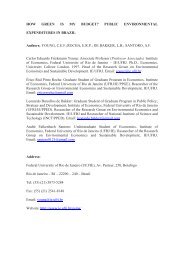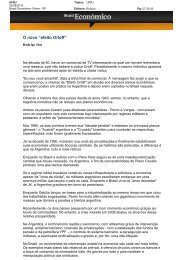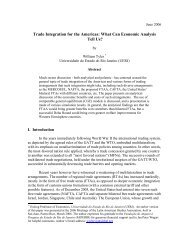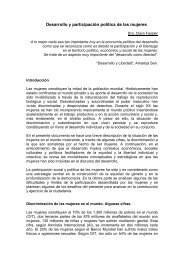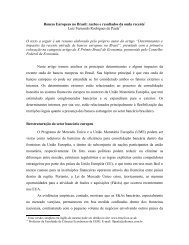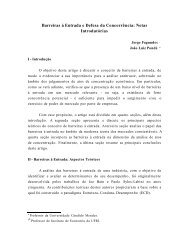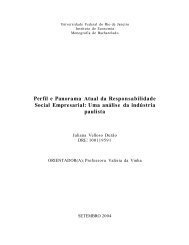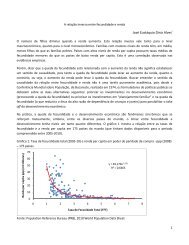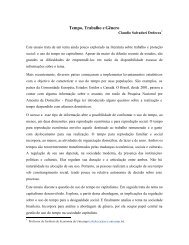The determinants and effects of foreign bank entry - Instituto de ...
The determinants and effects of foreign bank entry - Instituto de ...
The determinants and effects of foreign bank entry - Instituto de ...
You also want an ePaper? Increase the reach of your titles
YUMPU automatically turns print PDFs into web optimized ePapers that Google loves.
<strong>The</strong> <strong><strong>de</strong>terminants</strong> <strong>and</strong> <strong>effects</strong> <strong>of</strong> <strong>foreign</strong> <strong>bank</strong> <strong>entry</strong> inArgentina <strong>and</strong> Brazil: a comparative analysis +Version: February 2006Luiz Fern<strong>and</strong>o <strong>de</strong> Paula * <strong>and</strong> Antonio José Alves, Jr **Abstract: This paper aims at analyzing the recent experience <strong>of</strong> <strong>foreign</strong> <strong>bank</strong> <strong>entry</strong> in Argentina <strong>and</strong>Brazil, focusing in its <strong><strong>de</strong>terminants</strong> <strong>and</strong> <strong>effects</strong>. It shows that the experience <strong>of</strong> <strong>foreign</strong> <strong>bank</strong> <strong>entry</strong> inArgentina <strong>and</strong> Brazil has evi<strong>de</strong>nced that the penetration <strong>of</strong> <strong>foreign</strong> <strong>bank</strong>s in these countries has notcontributed effectively to the improvement <strong>of</strong> the macroeconomic efficiency <strong>of</strong> financial system.<strong>The</strong> expected results <strong>of</strong> the <strong>foreign</strong> <strong>bank</strong> <strong>entry</strong> – more diversified portfolio with predominance <strong>of</strong>credit operations, greater efficiency <strong>and</strong> enhancement <strong>of</strong> the soundness <strong>of</strong> the financial system - didnot materialize in Argentina <strong>and</strong> Brazil. In both countries <strong>foreign</strong> <strong>bank</strong>s behavior was similar todomestic private <strong>bank</strong>s, in terms <strong>of</strong> portfolio allocation, credit policy, etc, although in Argentinathere are some evi<strong>de</strong>nces that in tranquil times <strong>foreign</strong> <strong>bank</strong> <strong>entry</strong> contributed to the enhancement <strong>of</strong>the financial system.Key-words: <strong>foreign</strong> <strong>bank</strong>s; emerging countries; Argentina; BrazilJEL classification: G15; G21; G341 IntroductionIn the recent years, <strong>foreign</strong> <strong>bank</strong> <strong>entry</strong> has increased a great <strong>de</strong>al in emerging marketeconomies (EMEs). Latin America <strong>and</strong> the transition countries <strong>of</strong> Central Europe – wherein some countries <strong>foreign</strong> <strong>bank</strong>s have already over fifty percent <strong>of</strong> total <strong>bank</strong>ing assets -have been quickest to permit <strong>foreign</strong> participation in <strong>bank</strong>ing, while in Asia, Africa, theMiddle East, <strong>and</strong> the former Soviet Union, progress has been much more mo<strong>de</strong>st. In oneh<strong>and</strong>, this trend is a consequence <strong>of</strong> the process <strong>of</strong> <strong>bank</strong>ing internationalisation <strong>of</strong> somefinancial firms that result from both financial <strong>de</strong>regulation <strong>and</strong> technological changes thathave changed <strong>de</strong>eply the l<strong>and</strong>scape <strong>of</strong> <strong>bank</strong>ing industry all around the world. Financialinstitutions are seeking to diversity their activities – in terms <strong>of</strong> products <strong>and</strong> services,+ This paper is part <strong>of</strong> a broa<strong>de</strong>r study that was <strong>de</strong>veloped by Musashi University Research Institute, Japan,titled “An international comparative study <strong>of</strong> the impacts <strong>of</strong> globalization on the socio-economictransfiguration <strong>and</strong> acculturation <strong>of</strong> each areas <strong>and</strong> nations in Japan, the U.S.A., East Asia, China, <strong>and</strong> LatinAmerica”.* Associate Pr<strong>of</strong>essor <strong>of</strong> Economics at University <strong>of</strong> the State <strong>of</strong> Rio <strong>de</strong> Janeiro <strong>and</strong> Researcher <strong>of</strong> CNPq.E-mail: luizfpaula@terra.com.br <strong>and</strong> webmail: http://paginas.terra.com.br/educacao/luizfpaula** Associate Pr<strong>of</strong>essor <strong>of</strong> Economics at Rural Fe<strong>de</strong>ral University <strong>of</strong> the Rio <strong>de</strong> Janeiro <strong>and</strong> Researcher <strong>of</strong>CNPq. E-mail: antoniojbr@yahoo.com.br
<strong>and</strong>/or geographically – <strong>and</strong> to increase their minimum scale <strong>of</strong> operations to remaincompetitive <strong>and</strong> to enhance their ability to generate pr<strong>of</strong>its. On the other h<strong>and</strong>, <strong>foreign</strong> <strong>bank</strong><strong>entry</strong>, particularly in EMEs, is the result <strong>of</strong> the flexibility <strong>of</strong> the legal rules concerning thetreatment related to <strong>foreign</strong> <strong>bank</strong> penetration. Its motivation is mainly related to thepossible benefits <strong>of</strong> <strong>foreign</strong> <strong>bank</strong> penetration in terms <strong>of</strong> mo<strong>de</strong>rnisation <strong>and</strong> strengthening<strong>of</strong> the domestic financial system.<strong>The</strong> recent expansion <strong>of</strong> <strong>foreign</strong> <strong>bank</strong>s in Latin American countries is veryimpressive in terms <strong>of</strong> its rhythm. A recent IMF study relates that the participation <strong>of</strong><strong>foreign</strong> <strong>bank</strong>s from Spain, US, United Kingdom <strong>and</strong> Netherl<strong>and</strong>s in the total LatinAmerican <strong>bank</strong>ing assets grew quickly, changing <strong>de</strong>eply the ownership structure <strong>of</strong> thefinancial system (Clarke et al, 2001). This <strong>de</strong>velopment reflects a new <strong>bank</strong>ing strategy <strong>of</strong>international expansion. Banks have not exp<strong>and</strong>ed abroad only to serve its homemultinational enterprise <strong>and</strong>/or to explore opportunities that come from international tra<strong>de</strong>,but also, <strong>and</strong> increasingly, to dispute domestic markets with local <strong>bank</strong>s in host countries.This transnational rivalry between <strong>bank</strong>s is accompanied by <strong>bank</strong> functions re<strong>de</strong>finition.<strong>The</strong> traditional lending-<strong>de</strong>posit business that no longer characterized <strong>bank</strong>ing firms wasshifted by the universal global <strong>bank</strong> that combines ancient commercial functions withactivities proper <strong>of</strong> investment <strong>bank</strong>s. <strong>The</strong> diversification <strong>of</strong> financial activities is one <strong>of</strong> thenew aspects <strong>of</strong> <strong>bank</strong>ing competition <strong>and</strong> it has been responsible by the <strong>de</strong>velopment <strong>of</strong>securitization <strong>and</strong> new connections between financial markets <strong>and</strong> credit markets.Argentina <strong>and</strong> Brazil experienced a simultaneous process <strong>of</strong> <strong>foreign</strong> <strong>bank</strong> <strong>entry</strong> afterthe 1994-95 Mexican crisis. <strong>The</strong> quick pace <strong>of</strong> growth <strong>of</strong> <strong>foreign</strong> <strong>bank</strong>s into the Argentine<strong>and</strong> Brazilian <strong>bank</strong>ing system was seen by the monetary authorities as a solution to face the<strong>effects</strong> <strong>of</strong> Mexican crisis over the domestic financial system. According to the literature,with the entrance <strong>of</strong> <strong>foreign</strong> <strong>bank</strong>s, emerging countries could (i) have better access t<strong>of</strong>oreign savings, an essential ingredient to finance <strong>de</strong>velopment; (ii) enhance financialsystem increasing its soundness in or<strong>de</strong>r to improve the countries’ resistance to shocks;(iii) incorporate new financial technologies, introducing new management methods <strong>and</strong>new financial products; (iv) to improve operational efficiency <strong>of</strong> <strong>bank</strong>ing sector (Levine,1996; Peek <strong>and</strong> Rosengren, 2000). It was expected that this set <strong>of</strong> changes would converge2
to growing credit facilities <strong>and</strong> strengthening historically incipient domestic capitalmarkets.<strong>The</strong> results <strong>of</strong> <strong>foreign</strong> <strong>bank</strong> <strong>entry</strong> in Argentina <strong>and</strong> Brazil, however, did not reachwhat was expected initially. <strong>The</strong> evi<strong>de</strong>nces show that financial system efficiency, that is,the financial system capacity to create finance to sustain production <strong>and</strong> investment, has notimproved in Argentina <strong>and</strong> Brazil. <strong>The</strong> increased presence <strong>of</strong> big <strong>foreign</strong> global <strong>bank</strong>s inArgentine <strong>and</strong> Brazil, since 1995, has not resulted in a sustainable credit growth; themacroeconomic instability has been the hallmark in the two countries.This paper aims at analyzing the recent experience <strong>of</strong> <strong>foreign</strong> <strong>bank</strong> <strong>entry</strong> inArgentina <strong>and</strong> Brazil, focusing in its <strong><strong>de</strong>terminants</strong> <strong>and</strong> <strong>effects</strong> 1 . It is divi<strong>de</strong>d in 5 sectionsplus this introduction. Section 2 examines the concept <strong>of</strong> efficiency <strong>of</strong> the financial system,with special emphasis on the <strong>effects</strong> <strong>of</strong> <strong>foreign</strong> <strong>bank</strong> <strong>entry</strong> in EMEs. Section 3 analyses the<strong><strong>de</strong>terminants</strong> <strong>of</strong> <strong>foreign</strong> <strong>bank</strong> penetration in Argentina <strong>and</strong> Brazil, while section 4 examinesits <strong>effects</strong> on the domestic financial system. Finally, section 5 summarizes the mainarguments <strong>de</strong>veloped in the paper.2 Financial system efficiency <strong>and</strong> the <strong>foreign</strong> <strong>bank</strong>s<strong>The</strong> concept <strong>of</strong> efficiency <strong>of</strong> financial systems is a measure <strong>of</strong> its success inreaching macro <strong>and</strong> microeconomic efficiency. Efficiency has two distinct functions: oneconcerns the stability <strong>of</strong> the financial system; another is related to the allocation <strong>of</strong> the realresources. Macroeconomic efficiency concerns to the stability <strong>of</strong> the financial system, bothas a payment system <strong>and</strong> as an intermediary <strong>of</strong> loanable funds, that is how financial systemsupports financially stable growth. Microeconomic efficiency relates to the ability toprovi<strong>de</strong> finance <strong>and</strong> funding for the investors <strong>and</strong> other economic agents at the lowestpossible cost 2 .Microeconomic efficiency means that <strong>bank</strong> spread must not be greater than thenecessary to cover the interest paid, administrative costs <strong>and</strong> credit risk. <strong>The</strong> literaturepoints out that the increasing presence <strong>of</strong> <strong>foreign</strong> <strong>bank</strong>s could bring positive <strong>effects</strong> to the1 <strong>The</strong> paper focuses mainly on the period <strong>of</strong> economic instability <strong>of</strong> Argentina <strong>and</strong> Brazil. For this reason, wedo not analysis the recent economic recovery <strong>of</strong> both economies.2 <strong>The</strong> concept <strong>of</strong> efficiency <strong>of</strong> financial systems is explored by Studart (1995-96).3
<strong>de</strong>gree <strong>of</strong> efficiency <strong>of</strong> the domestic financial system, as <strong>foreign</strong> <strong>bank</strong>s are generally moreefficient than domestic competitors (Clarke et al, 2001). For example, Focarelli <strong>and</strong>Pozzolo (2000) argue that <strong>foreign</strong> <strong>bank</strong>s go to <strong>de</strong>veloping countries in or<strong>de</strong>r to explore therelative inefficiency <strong>of</strong> domestic <strong>bank</strong>s. In general, <strong>bank</strong>s that exp<strong>and</strong> abroad are typicallythe ‘best <strong>of</strong> the crop’ in the country <strong>of</strong> origin. <strong>The</strong>y show that <strong>foreign</strong> <strong>bank</strong>s are moreefficient than domestic <strong>bank</strong>s in EMEs, introducing into the host countries better practices<strong>of</strong> management <strong>and</strong> new technologies. Thus, one can conclu<strong>de</strong> that the increase presence <strong>of</strong><strong>foreign</strong> <strong>bank</strong>s must improve the microeconomic efficiency, lowering the costs <strong>of</strong> supply <strong>of</strong>credit.Macroeconomic efficiency is obtained when <strong>bank</strong>ing system provi<strong>de</strong>s loans insufficient volume to finance investments <strong>and</strong> other spending in or<strong>de</strong>r to achieve fullemploymentwith the possible minimum increase in financial fragility. In globalized openeconomies, the functioning <strong>of</strong> the <strong>bank</strong>ing system must avoid vulnerability to internationalrate <strong>of</strong> interest <strong>and</strong> exchange rate shocks in or<strong>de</strong>r to be consi<strong>de</strong>red as efficient.<strong>The</strong> empirical literature presents some evi<strong>de</strong>nces <strong>of</strong> positive macroeconomicimpacts associated with the increasing presence <strong>of</strong> <strong>foreign</strong> <strong>bank</strong>s in EMEs. First, global<strong>bank</strong>s bring to the host country practices consistent with the financial <strong>and</strong> regulatoryreporting requirements <strong>of</strong> their home country. As financial reports <strong>of</strong> global <strong>bank</strong>s aresupposed to be more <strong>de</strong>tailed <strong>and</strong> better accountable than <strong>de</strong>veloping countries ones, thepresence <strong>of</strong> <strong>foreign</strong> <strong>bank</strong>s in domestic financial system is an incentive to local <strong>bank</strong>s toadopt better accounting practices (Peek <strong>and</strong> Rosengren, 2000, p.48). This, in practice,reduce the risks associated with financial intermediation <strong>and</strong> should increase credit supply.Second, <strong>foreign</strong> <strong>bank</strong>s are less sensitive to domestic shocks than domestic <strong>bank</strong>s. Astheir portfolios are better diversified, the impact <strong>of</strong> a domestic shock, that could seriouslyaffect domestic <strong>bank</strong>s would be more easily absorbed by <strong>foreign</strong> <strong>bank</strong>s 3 . If all this is true, afinancial system entirely occupied by domestic <strong>bank</strong>s should be more vulnerable to3 As CGFS (2004, p. 1) states, “<strong>foreign</strong> <strong>bank</strong>s’ can also help to achieve greater financial stability in hostcountries. Host countries may benefit immediately from <strong>foreign</strong> <strong>entry</strong>, if the <strong>foreign</strong> <strong>bank</strong> recapitalises astruggling local institution <strong>and</strong>, in the process, also provi<strong>de</strong>s nee<strong>de</strong>d balance <strong>of</strong> payments financing. <strong>The</strong>better capitalisation <strong>and</strong> wi<strong>de</strong>r diversification <strong>of</strong> <strong>foreign</strong> <strong>bank</strong>s, along with the access <strong>of</strong> local operations toparent funding, may reduce the sensibility <strong>of</strong> the host country <strong>bank</strong>ing system to local business cycles <strong>and</strong>changing financial market conditions. <strong>The</strong>ir use <strong>of</strong> risk-based credit evaluation (<strong>and</strong> spillovers to local <strong>bank</strong>s’practices) tends to reduce concentration in lending <strong>and</strong>, in times <strong>of</strong> financial distress, foresters prompter4
As we will see in the next section, there is no reason to suppose that <strong>foreign</strong> <strong>bank</strong><strong>entry</strong> resulted in a significant improvement in the finance conditions <strong>of</strong> Argentine <strong>and</strong>Brazilian economies <strong>and</strong> also in their financial stability. In<strong>de</strong>ed, <strong>foreign</strong> <strong>bank</strong> <strong>entry</strong> inArgentina <strong>and</strong> Brazil did not cause any greater change in the <strong>bank</strong>ing behavior in terms <strong>of</strong>portfolio allocation, credit policy etc. This is explained by the fact that <strong>bank</strong>ing behaviorhas been mainly <strong>de</strong>termined by the macro-institutional environment <strong>of</strong> both countries, thathas resulted in a convergence <strong>of</strong> behavior <strong>of</strong> both domestic <strong>and</strong> <strong>foreign</strong> <strong>bank</strong>s. In particular,macroeconomic instability prevented the <strong>de</strong>velopment <strong>of</strong> financial relations in Argentina<strong>and</strong> Brazil.3 Determinants <strong>of</strong> <strong>foreign</strong> <strong>bank</strong> <strong>entry</strong> in Argentina <strong>and</strong> Brazil3.1 Determinants <strong>of</strong> <strong>foreign</strong> <strong>bank</strong> <strong>entry</strong> in Latin AmericaBanking crises, <strong>de</strong>regulation <strong>and</strong> globalization <strong>of</strong> financial services have led to asignificant increase in the presence <strong>of</strong> <strong>foreign</strong> <strong>bank</strong>s in EMEs in the second half <strong>of</strong> the1990s. Consolidation has accelerated recently in <strong>bank</strong>ing industry in EMEs, changing atraditionally highly protected industry. In this connection, Hawkins <strong>and</strong> Mihaljek (2001, p.3) states that “global market <strong>and</strong> technology <strong>de</strong>velopments, macroeconomic pressures <strong>and</strong><strong>bank</strong>ing crises in the 1990s have forced the <strong>bank</strong>ing industry <strong>and</strong> the regulators to changethe old way <strong>of</strong> doing business, <strong>and</strong> to <strong>de</strong>regulate the <strong>bank</strong>ing industry at the national level<strong>and</strong> open up financial markets to <strong>foreign</strong> competition. (…) <strong>The</strong>se changes havesignificantly increased competitive pressures on <strong>bank</strong>s in the emerging economies <strong>and</strong> haveled to <strong>de</strong>ep changes in the structure <strong>of</strong> the <strong>bank</strong>ing industry”.Although the same forces <strong>of</strong> changes are <strong>de</strong>termining the process <strong>of</strong> <strong>bank</strong>ingconsolidation in mature markets (US, EU <strong>and</strong> Japan) <strong>and</strong> emerging markets (Asia, LatinAmerican <strong>and</strong> Central Europe), there are some particular features when ones compare bothexperiences (IMF, 2000) 5 :a) International mergers <strong>and</strong> acquisitions (M&As) cross-bor<strong>de</strong>r are an exception inmature economies, but they are the rule in emerging markets. In emerging markets it can beobserved an increase in the market share <strong>of</strong> <strong>foreign</strong> <strong>bank</strong>s in the domestic <strong>bank</strong>ing sector,6
while this trend is weaker in mature countries. In<strong>de</strong>ed, in the latter countries <strong>bank</strong>ingconsolidation emerged as a consequence <strong>of</strong> financial <strong>de</strong>regulation implemented during the1980s <strong>and</strong> 1990s, as typically is the case <strong>of</strong> US where the segmentation <strong>of</strong> the financialsystem was gradually being ero<strong>de</strong>d. On the other h<strong>and</strong>, in emerging markets internationalM&As cross-bor<strong>de</strong>r, involving <strong>foreign</strong> <strong>bank</strong>s, in most countries have been the rule. 6b) Banking consolidation in mature markets has served mainly to increase theefficiency - in the search <strong>of</strong> scale economies, scope economies <strong>and</strong> revenue economies -<strong>and</strong>/or the market power <strong>of</strong> the major <strong>bank</strong>s 7 , while in EMEs it served mostly to help t<strong>of</strong>ace <strong>bank</strong>ing crises during the 1990s. Banking crises caused enormous disturbs in emergingcountries, in most cases due to the very nature <strong>of</strong> financial liberalization. Banking crisesaccelerated, if not <strong>de</strong>termined, the implementation <strong>of</strong> privatization programs <strong>of</strong> publicsector<strong>bank</strong>s.c) In most cases, <strong>bank</strong>ing consolidation in emerging markets was <strong>of</strong> the type‘government-driven’, that is the government conducted directly or indirectly the process <strong>of</strong><strong>bank</strong>ing consolidation through programs <strong>of</strong> <strong>bank</strong>ing restructuring, privatization <strong>of</strong> public<strong>bank</strong>s, flexibility in the rules <strong>of</strong> <strong>foreign</strong> <strong>bank</strong> <strong>entry</strong>, etc., while in mature markets it wasmainly ‘market-driven’ style, that is it was the result <strong>of</strong> the responses <strong>of</strong> financialinstitutions to the policies <strong>of</strong> financial <strong>de</strong>regulation <strong>and</strong> privatization during the 1970s <strong>and</strong>1980s.Banking consolidation in Latin America has been the most advanced among theEMEs. <strong>The</strong> main ‘forces <strong>of</strong> change’ <strong>of</strong> this process were the <strong>bank</strong>ing crises that resultedfrom the 1994 Mexican crisis contagious <strong>and</strong> the consequent <strong>foreign</strong> <strong>bank</strong>s <strong>entry</strong>:“Financial crises <strong>and</strong> the need to (re-)establish functioning <strong>bank</strong>ing systems created a onetimeset <strong>of</strong> opportunities to invest in financial institutions <strong>and</strong> to exp<strong>and</strong> business in EMEsin the second half <strong>of</strong> the 1990s. A st<strong>and</strong>ard response to crises by EME government,encouraged by the international financial institutions, was to accelerate financial5 See also Dymski (2002) for an analysis on the implications <strong>of</strong> the current global <strong>bank</strong> merger for <strong>de</strong>velopingcountries.6 According to Hawkins <strong>and</strong> Mihaljek (2001, p. 24), in central Europe, the share <strong>of</strong> <strong>foreign</strong> <strong>bank</strong>s in terms <strong>of</strong>both total <strong>of</strong> assets <strong>and</strong> capital is now around two thirds or higher, making these countries’ <strong>bank</strong>ing systemsamong the most open in the world, while in Latin America, the market share <strong>of</strong> <strong>foreign</strong> <strong>bank</strong>s rose from anaverage <strong>of</strong> 7 percent in the beginning <strong>of</strong> the 1990s to 40 percent in 2000.7
liberalization <strong>and</strong> to recapitalize <strong>bank</strong>s with the help <strong>of</strong> <strong>foreign</strong> investors. This was the casein Latin America in the years following the 1994 Mexican crisis”. (CGFS, 2004, p. 6)<strong>The</strong>refore, there was an active government role in the conduction <strong>of</strong> <strong>bank</strong>ingconsolidation in Latin America after the Mexican crisis, although since late-1990s thisprocess has been increasingly market-driven. Note that in Latin America, contrasting withthe main countries in Asia <strong>and</strong> Central Europe, the reduction in the quantity <strong>of</strong> <strong>bank</strong>inginstitutions was followed by a remarked increasing in <strong>bank</strong>ing concentration (exceptedVenezuela), according to Table 1.Table 1. Banking concentration in some selected emerging countries1994 2000CountriesBanksquantity(1994)Market share –total <strong>of</strong> <strong>de</strong>posits(%)Threemajor<strong>bank</strong>sTenmajor<strong>bank</strong>sHHIn<strong>de</strong>x(1994)Banksquantity(2000)Market share –total <strong>of</strong> <strong>de</strong>posits(%)Threemajor<strong>bank</strong>sTenmajor<strong>bank</strong>sHHIn<strong>de</strong>x(2000)AsiaKorea 30 52.8 86.9 1263.6 13 43.5 77.7 899.7Malaysia 25 44.7 78.3 918.9 10 43.4 82.2 1005.1Philippines 41 39.0 80.3 819.7 27 39.6 73.3 789.9Thail<strong>and</strong> 15 47.5 83.5 1031.7 13 41.7 79.4 854.4Latin AmericaArgentina 206 39.1 73.1 756.9 113 39.8 80.7 865.7Brazil 245 49.9 78.8 1220.9 193 55.2 85.6 1278.6Chile 37 39.5 79.1 830.4 29 39.5 82.0 857.9Mexico 36 48.3 80.8 1005.4 23 56.3 94.5 1360.5Venezuela 43 43.9 78.6 979.2 42 46.7 75.7 923.1Central EuropeCzech Republic 55 72.0 97.0 2101.5 42 69.7 90.3 1757.8Hungary 40 57.9 84.7 1578.8 39 51.5 80.7 1241.2Pol<strong>and</strong> 82 52.8 86.9 1263.6 77 43.5 77.7 899.7Fonte: IMF (2000, p. 127)7 See, in this connection, Dymski (1999), <strong>and</strong> Santomero <strong>and</strong> Eckles (2000).8
Overall, the share <strong>of</strong> <strong>bank</strong> assets held by <strong>foreign</strong> <strong>bank</strong>s in EMEs has increasedconsi<strong>de</strong>rably since 1990. Foreign ownership <strong>of</strong> the <strong>bank</strong>ing sector is substantially higher inLatin America <strong>and</strong> central <strong>and</strong> eastern Europe than in Asia. (Table 2) While in central <strong>and</strong>Eastern Europe <strong>foreign</strong> <strong>bank</strong>s now control more than 60 percent <strong>of</strong> total <strong>bank</strong>ing assets, inthe major countries <strong>of</strong> Latin America, except Brazil, the share <strong>of</strong> assets owned by <strong>foreign</strong><strong>bank</strong>s is more than 30 percent. In Mexico <strong>and</strong> Argentina the market share <strong>of</strong> <strong>foreign</strong> <strong>bank</strong>s(in terms <strong>of</strong> total assets) was 48 percent <strong>and</strong> 82 percent in 2004, respectively.Table 2. Share <strong>of</strong> <strong>bank</strong> assets held by <strong>foreign</strong> <strong>bank</strong>s¹Countries 1990 2004²in per cent<strong>of</strong> GDPin billions <strong>of</strong>USDCentral <strong>and</strong> eastern EuropeBulgaria 0 80 49 13Czech Republic 10 96 92 99Estonia ... 97 89 11Hungary 10 83 67 68Pol<strong>and</strong> 3 68 43 105Emerging AsiaChina 0 2 4 71Hong Kong 89 72 344 570Índia 5 8 6 36Korea 4 8 10 65Malaysia ... 18 27 32Singapore 89 76 148 159Thail<strong>and</strong> 5 18 20 32Latin AmericaArgentina 10 48 20 31Brazil 6 27 18 107Chile 19 42 37 35México 2 82 51 342Peru 4 46 14 11Venezuela 1 34 9 9¹ Percentage share <strong>of</strong> total <strong>bank</strong> assets. ² Or latest available year.Source: Domanski (2005, p. 72), based on data from ECB <strong>and</strong> national central <strong>bank</strong>s.Following the increase <strong>of</strong> the market share, the range <strong>of</strong> <strong>foreign</strong> <strong>bank</strong> activity inEMEs has broa<strong>de</strong>ned a great <strong>de</strong>al recently. Historically, <strong>foreign</strong> <strong>bank</strong>s focused primarily onthe provision <strong>of</strong> financial services to their home-country clients in internationaltransactions. However, since the 1990s, <strong>foreign</strong> investments have increasingly been drivenby more general pr<strong>of</strong>it opportunities in local markets. In<strong>de</strong>ed, the present strategy <strong>of</strong> globaluniversal <strong>bank</strong>s is aimed at diversifying their activities into some domestic markets through9
a network <strong>of</strong> branches <strong>and</strong> greater integration into the local market, while in the past <strong>bank</strong>’sstrategies were geared mainly to serving their home-country customers <strong>and</strong> also givingsome support to domestic firms to access the international financial market. 8Latin America received one <strong>of</strong> the biggest influxes <strong>of</strong> <strong>foreign</strong> direct investment(FDI) in the <strong>bank</strong>ing sector since the middle <strong>of</strong> the 1990s. However, one cannot un<strong>de</strong>rst<strong>and</strong>the wave <strong>of</strong> <strong>bank</strong> FDI isolated from the general movement <strong>of</strong> FDI to Latin America duringthe 1990s. In<strong>de</strong>ed, the Latin America <strong>and</strong> Caribbean region received record levels <strong>of</strong> FDI inthe 1990s, with inflows totaling US$ 76,7 billion only in 1998, an amount thatcorrespon<strong>de</strong>d to around 41 percent <strong>of</strong> total FDI flows to <strong>de</strong>veloping countries. (ECLAC,2000, p.35-6) <strong>The</strong> majority <strong>of</strong> FDI flows in financial sector went to Latin America as well.Between 1991 <strong>and</strong> 2005, transactions targeting <strong>bank</strong>s in the region accounted for US$ 58billion or 48 percent <strong>of</strong> total cross-bor<strong>de</strong>r M&As targeting <strong>bank</strong>s in EMEs, followed byemerging Asia with US$ 43 billion (36 percent <strong>of</strong> total M&As) <strong>and</strong> central <strong>and</strong> EasternEurope with US$ 20 billion (17 percent <strong>of</strong> total M&As). 9In 1991-2005, the majority <strong>of</strong> FDI in <strong>bank</strong>ing sector to Latin America came fromEuropean countries: 46.6 percent from Spain, 10.0 percent from United Kingdom, <strong>and</strong> 6.4percent from Netherl<strong>and</strong>s 10 (Domanski, 2005, p. 75). Some <strong>of</strong> the main <strong><strong>de</strong>terminants</strong> <strong>of</strong> theexpansion <strong>of</strong> European <strong>bank</strong>s in Latin America can be summarized as follows:<strong>The</strong> process <strong>of</strong> restructuring <strong>of</strong> the <strong>bank</strong>ing sector un<strong>de</strong>r European economic <strong>and</strong>monetary union. For some European <strong>bank</strong>s exp<strong>and</strong>ing abroad is not only a source <strong>of</strong>earnings diversification, but also a way <strong>of</strong> strengthening their position in European<strong>bank</strong>ing market consi<strong>de</strong>ring the increasing market competition in <strong>bank</strong>ing in theEuropean Economic Area. <strong>The</strong> European <strong>bank</strong>’s strategy for Latin America may beinterpreted as a response to this more competitive environment, in which severalfactors were eroding income from traditional <strong>bank</strong>ing business 11 . Further, due topolitical <strong>and</strong> regulatory constraints, there are some impediments to M&As withinEU countries, but incentives to such activity outsi<strong>de</strong> the bloc 12 . <strong>The</strong> preference for8 See more in Focarelli <strong>and</strong> Pozzolo (2000).9 According to Domanski (2005, p. 70-71) with data extracted from Thompson Financial.10 US accounted for 26.5 percent <strong>and</strong> Canada for 3.6%.11 This hypothesis is <strong>de</strong>veloped by Paula (2002).12 One <strong>of</strong> these incentives is the absence <strong>of</strong> a single regulatory agency in the European Union (EU). This haslimited the benefits <strong>of</strong> exp<strong>and</strong>ing areas <strong>of</strong> activity across bor<strong>de</strong>rs <strong>and</strong>, at the same time, prevented European10
Latin America, <strong>and</strong> to a lesser <strong>de</strong>gree Central <strong>and</strong> Eastern Europe, is partiallybecause during the second-half <strong>of</strong> 1990s Southeast Asia was in crisis, <strong>and</strong> Indian<strong>and</strong> Chinese financial system have been closed to <strong>foreign</strong> <strong>bank</strong>s, leaving Argentina,Brazil <strong>and</strong> Mexico as the main big emerging markets open to FDI in <strong>bank</strong> sector.In particular, the dynamics <strong>of</strong> the internationalization <strong>of</strong> the Spanish <strong>bank</strong>s sincethey were the main protagonists in the recent wave <strong>of</strong> <strong>foreign</strong> <strong>bank</strong>s entering LatinAmerica. <strong>The</strong>se <strong>bank</strong>s pursued growth strategies based on M&As in their naturalmarket before they launched their international growth strategy. So, they alreadywere ‘mature’ <strong>bank</strong>s when they <strong>de</strong>ci<strong>de</strong>d to exp<strong>and</strong> overseas. In<strong>de</strong>ed, with theimplementation <strong>of</strong> EMU <strong>and</strong> the perspective <strong>of</strong> introduction <strong>of</strong> the euro, the largerSpanish <strong>bank</strong>s – in particular, Banco Bilbao Vizcaya (BBV), Banco Sant<strong>and</strong>er <strong>and</strong>Banco Central Hispanico (BCH) had to look beyond their natural bor<strong>de</strong>rs in search<strong>of</strong> global markets, in or<strong>de</strong>r to maintain their competitive position <strong>and</strong> to <strong>de</strong>fendthemselves from the threat <strong>of</strong> hostile bids by either local <strong>and</strong> <strong>foreign</strong> competitors. Atthe initial stages <strong>of</strong> this process there was a proliferation <strong>of</strong> alliances <strong>and</strong> cooperationagreements with other financial institutions, chiefly within the EuropeanUnion, while the second phase has involved a fast-paced, aggressive expansionstrategy aimed at the main Latin American markets 13 .<strong>The</strong> <strong>de</strong>regulation process in Latin America, in the broa<strong>de</strong>r context <strong>of</strong> economic <strong>and</strong>political reforms, since early 1990s, ma<strong>de</strong> room for the <strong>entry</strong> <strong>of</strong> <strong>foreign</strong> companiesinto key economic sectors, such as <strong>bank</strong>ing, telecommunications <strong>and</strong> utilities. Bankprivatization programs in general formed part <strong>of</strong> longer-term public sector reforms,which also involved privatization <strong>of</strong> major public enterprises with the aim <strong>of</strong>consolidating the public finances <strong>and</strong> cutting borrowing requirements (Hawkins <strong>and</strong>Mihaljek, 2001, p. 13). Further, <strong>de</strong>epening the role <strong>of</strong> the market was also a majormotive.<strong>bank</strong>s from engaging in the diversification <strong>of</strong> earnings <strong>and</strong> reduction in the regulatory capital, practiced in theUS. Although the Single Market Act <strong>and</strong> the various European commission financial directives should havecreated some uniformity, difficulties have arisen <strong>and</strong> hampered cross-bor<strong>de</strong>r operations. <strong>The</strong>re are multiplesupervisory agencies within European countries <strong>and</strong> no co-ordination agency or single <strong>bank</strong> regulatory bodyfor the entire euro area. As a result, M&As remain to a greater extent confined within national bor<strong>de</strong>rs. Seemore in Kregel (2002).11
<strong>The</strong> Latin American <strong>bank</strong>ing sector <strong>of</strong>fers much better prospects for increasingreturns to financial institutions, since the intermediation margins with which <strong>bank</strong>soperate in these countries are consi<strong>de</strong>rably higher than in the <strong>de</strong>veloped world.While the domestic <strong>bank</strong>s’ average margin on assets (net interest income over totalassets) in Latin America was 5.76 percent for the period 1988-95 (in Brazil it was6.6 percent <strong>and</strong> Argentina 9.9 percent), in OECD’s countries it was 2.80 percent forthe same period (Claessens et al, 2001). On the other h<strong>and</strong>, Latin American <strong>bank</strong>ssteadily improved their already high pr<strong>of</strong>itability during the 1990s, although netinterest revenue has been stable. <strong>The</strong>ir pr<strong>of</strong>itability is high both compared to G3’scountries <strong>and</strong> other EMEs. 14<strong>The</strong> potential gains in efficiency are high in Latin America, since the <strong>de</strong>gree <strong>of</strong><strong>bank</strong>ing efficiency is in general lower than that in <strong>de</strong>veloped countries. <strong>The</strong>domestic <strong>bank</strong>s’ ratio <strong>of</strong> operating costs to assets in Latin America was on average5.5% in 1992-1997, while it was 1.7% in G3’s countries (US, Japan <strong>and</strong> Germany),1.6% in East Asia <strong>and</strong> 4.1% in Central Europe, in the same period, (Hawkins <strong>and</strong>Kihaljek, 2002, p. 6) <strong>The</strong> high operating cost (as well as high interest rate spreads)<strong>of</strong> domestic <strong>bank</strong>s in Latin America are in large part the legacy <strong>of</strong> the high-inflationperiod <strong>of</strong> the 1980s <strong>and</strong> the early 1990s, when inflationary revenues generated easypr<strong>of</strong>its for the <strong>bank</strong>s <strong>and</strong>, consequently, there was little pressure to cut costs.3.2 Determinants <strong>and</strong> some features <strong>of</strong> <strong>foreign</strong> <strong>bank</strong> <strong>entry</strong> in Argentina <strong>and</strong> Brazil<strong>The</strong> recent process <strong>of</strong> <strong>bank</strong>ing consolidation in Argentina is somehow similar to theBrazilian experience in the sense that in both countries the authorities respon<strong>de</strong>d to the<strong>bank</strong>ing crisis caused by the <strong>effects</strong> <strong>of</strong> the contagious <strong>of</strong> 1994-95 Mexican crisis with anarray <strong>of</strong> support programs for financial institutions <strong>and</strong> their borrowers. <strong>The</strong>se programsinten<strong>de</strong>d to bolster the health <strong>of</strong> the financial sector <strong>and</strong>, at the same time, to open thesector to <strong>foreign</strong> <strong>bank</strong>s, since the presence <strong>of</strong> these <strong>bank</strong>s could help to strengthen the13 For an analysis <strong>of</strong> the expansion strategy <strong>of</strong> Spanish <strong>bank</strong>s to Latin America, see ECLAC (2000, Ch 3) <strong>and</strong>Sebastian <strong>and</strong> Hernansanz (2000).14 Pre-tax pr<strong>of</strong>its as percentage <strong>of</strong> total assets in 1992-1997 was 1.4 on average in Latin America, while it was0.7 in G3, 0.8 in East Asia, <strong>and</strong> 0.5 in Central Europe (Hawkins <strong>and</strong> Mihaljek, 2001, p. 6).12
anking sector 15 . Besi<strong>de</strong>s, the <strong>entry</strong> <strong>of</strong> <strong>foreign</strong> <strong>bank</strong>s was used as a policy to weaken theeffect <strong>of</strong> local monopolies that had been established un<strong>de</strong>r the previous regulatory structure.Both countries had important structural changes in their financial systems during the1990s, evi<strong>de</strong>nced by some <strong>de</strong>cline in the market share <strong>of</strong> state-owner <strong>bank</strong>s, a <strong>de</strong>crease inthe quantity <strong>of</strong> financial institutions, including <strong>bank</strong>s, <strong>and</strong> an increase in <strong>bank</strong>ingconcentration. In Argentina 1980s high inflation period caused shrinkage in the quantity <strong>of</strong><strong>bank</strong>ing <strong>and</strong> non-<strong>bank</strong>ing financial institutions probably due to the <strong>de</strong>ep process <strong>of</strong>economy’s <strong>de</strong>monetization. More recently, after the 1995 <strong>bank</strong>ing crisis, there was a huge<strong>de</strong>crease in the quantity <strong>of</strong> both public (provincial <strong>and</strong> municipal ones) <strong>and</strong> private <strong>bank</strong>sthat was followed by a quick increase in the <strong>bank</strong>ing concentration: top 10 <strong>bank</strong>s increasedfrom 50.6 percent in December 1994 to 77.7 percent <strong>of</strong> total <strong>of</strong> assets in December 2002, asignificant increase <strong>of</strong> more than 50 percent in <strong>bank</strong>ing concentration in just nine years (seeTable 3 <strong>and</strong> 5). In Brazil, <strong>bank</strong>ing consolidation, although less intensive than in Argentina,accelerated a great <strong>de</strong>al after 1995: Quantity <strong>of</strong> <strong>bank</strong>s (multiple <strong>and</strong> commercial ones)<strong>de</strong>clined from 240 <strong>bank</strong>s in December 1995 to 166 <strong>bank</strong>s in December 2002 (Table 4)while the market share <strong>of</strong> top 10 <strong>bank</strong>s (as percentage <strong>of</strong> total assets) increased from 63.4percent in December 1995 to 75.7 percent in December 2002 (Table 6). <strong>The</strong>se changes inthe <strong>bank</strong>ing sector in Argentina <strong>and</strong> Brazil can be attributed to some basic factors, such as<strong>bank</strong>ing restructuring policy, programs <strong>of</strong> <strong>bank</strong>ing privatization <strong>and</strong> the <strong>foreign</strong> <strong>bank</strong> <strong>entry</strong>,following some general trends <strong>of</strong> <strong>bank</strong>ing consolidation in EMEs, as we have seen in theformer section.15 See Dages et al (2000) for an analysis on the recent <strong>foreign</strong> <strong>bank</strong> penetration in <strong>and</strong> Argentina, <strong>and</strong> Paula(2002) for Brazilian case.13
Table 3. Financial institutions <strong>and</strong> branches in Argentina, 1980-2001December 1980 December 1991 December 1994 December 1996 December 2001BanksInstitution Branches Institution Branches Institution Branches Institution Branches Institution BranchesNational public-sector 4 695 6 931 6 907 3 553 2 614Provincial public-sector 31 1145 29 916 27 752 18 920 11 777Municipal public-sector 35 n. a. 35 1847 33 1659 21 1473 13 1391Private-sector domestic n. a. n. a. 57 1090 66 1198 53 1807 32 742Foreign-controlled 27 215 31 322 31 360 39 375 39 1831Cooperatives n. a. n. a. 44 799 38 842 6 350 2 236Total <strong>of</strong> private <strong>bank</strong>s 179 1999 132 2211 135 2400 98 2532 73 2809Total <strong>of</strong> <strong>bank</strong>ing sector 214 n.d. 167 4058 168 4059 119 4005 86 4200Non-<strong>bank</strong>ing institutions 255 280 47 28 37 22 26 44 22 73Total <strong>of</strong> financial system 469 n. a. 214 4086 205 4081 145 4049 108 4273Source: Central Bank <strong>of</strong> Argetina, in Fanelli (2003, p. 50).Table 4. Quantity <strong>of</strong> financial institutions operating into the Brazilian Financial SystemFinancial institutions Dec-93 Dec-94 Dec-95 Dec-96 Dec-97 Dec-98 Dec-99 Dec-00 Dec-01 Dec-02Multiple Banks 206 210 205 191 179 173 168 163 153 143Commercial Banks 35 34 35 38 36 28 25 28 28 23Development Banks 7 6 6 6 6 6 5 5 4 4Investment Banks 17 17 17 23 22 22 21 19 20 23Finance Companies 41 41 42 47 48 42 41 42 39 46Securities Brokers 285 280 271 255 237 228 192 186 177 160Securities Dealers 378 367 323 281 235 207 186 173 156 149Leasing companies 67 72 78 74 78 80 79 77 71 65Caixas Econômicas* 2 2 2 2 2 2 1 1 1 1S&Ls Association/Mortgage Societies 27 27 23 22 22 21 19 18 18 18MortgageCompanies - - - 3 3 4 6 7 7 6TOTAL 1065 1056 1002 942 868 813 743 719 674 638Source: Central Bank <strong>of</strong> Brazil, Financial System Organization Department.(*) “Caixas Econômicas” are public <strong>bank</strong>s (fe<strong>de</strong>ral or state ones) that combine commercial activities with housing financeactivities.14
Table 5. Banking concentration in Argentina (percentage <strong>of</strong> <strong>bank</strong>ing assets)End <strong>of</strong>: Top 5 Top 10 Top 15 Top 20 OthersNumber <strong>of</strong>BanksDecember 1993 38.19 51.28 59.73 65.71 34.29 167December 1994 36.43 50.57 58.83 64.89 35.11 168December 1995 39.88 55.18 64.00 69.29 30.71 127December 1996 38.71 55.67 66.37 72.38 27.62 120December 1997 40.89 57.73 67.64 74.05 25.95 113December 1998 42.82 64.03 73.56 80.03 19.97 104December 1999 45.64 68.20 77.44 83.23 16.77 92December 2000 45.63 69.35 79.00 85.09 14.91 89December 2001 48.71 70.90 80.97 87.01 12.99 85December 2002 57.16 77.72 86.10 90.38 9.62 78Source: Association <strong>of</strong> Banks <strong>of</strong> Argentina (ABA), with data from the Central Bank <strong>of</strong> Argentina.Table 6. Banking concentration in Brazil (as percentage <strong>of</strong> total assets)Period Semester Top 2 Top 5 Top 10 Top 201994 I 33.38 48.45 63.37 75.86II 33.41 49.91 62.82 75.701995 I 29.57 48.14 62.54 75.44II 30.46 50.44 63.39 75.341996 I 27.50 48.28 60.30 72.12II 29.14 50.95 62.73 75.561997 I 29.13 50.51 62.12 76.67II 30.76 51.46 63.74 78.771998 I 32.02 51.86 64.63 78.48II 34.64 55.81 69.77 83.311999 I 33.77 55.75 68.99 82.11II 33.03 54.72 69.27 83.302000 I 32.49 53.91 69.48 84.44II 31.17 57.09 74.58 88.222001 I 26.02 52.35 71.73 86.77II 27.08 53.19 71.84 86.382002 I 26.11 57.72 72.89 87.21II 28.88 57.96 75.74 89.09Source: Rocha (2001) until 2000; authors’ calculations for 2001-02, both with data fromCentral Bank <strong>of</strong> Brazil15
However, there are some differences <strong>and</strong> particular features when ones analysis therecent Argentine <strong>and</strong> Brazilian experiences related to <strong>foreign</strong> <strong>bank</strong> penetration.Firstly, financial liberalization was more intensive in Argentina than in Brazil.Financial liberalization in Argentina followed the implementation the Convertibility Plan 16 .Actually, currency board system required financial liberalization as a way to assure a high<strong>and</strong> stable influx <strong>of</strong> external capital in or<strong>de</strong>r to sustain an a<strong>de</strong>quate level <strong>of</strong> liquidity in thedomestic financial system. <strong>The</strong>refore, between 1989 <strong>and</strong> 1994, almost all the regulatorycontrols on domestic <strong>and</strong> external operations in the financial system, that had been replacedduring the 1980s due to the high inflation <strong>and</strong> external constraints, were lifted (Hermann,2001). Within this new context, <strong>foreign</strong> <strong>bank</strong>s had full freedom to issue <strong>de</strong>posits <strong>and</strong> toextend credit in <strong>foreign</strong> currency (that is, dollar), to get resources abroad, <strong>and</strong> to issuesubordinated <strong>de</strong>bt in external financial markets. In<strong>de</strong>ed, pru<strong>de</strong>ntial regulations stimulated astrong <strong>and</strong> quick increase in dollarization in Argentina during the 1990s. In Brazil financialliberalization was slower <strong>and</strong> more restrictive compared to Argentina: during the 1990sonly the investments <strong>of</strong> institutional investors in assets negotiated in Brazil were partiallyliberalized (Annex IV <strong>and</strong> V <strong>of</strong> Central Bank <strong>of</strong> Brazil), although non-resi<strong>de</strong>nt accounts in<strong>foreign</strong> markets (CC5) had been used very <strong>of</strong>ten by resi<strong>de</strong>nts – mainly financial institutions– to send dollars abroad during turbulent periods <strong>of</strong> speculative attach on the Braziliancurrency – the real 17 .Secondly, <strong>foreign</strong> <strong>bank</strong> opening up was much <strong>de</strong>eper in Argentina than in Brazilduring the 1990s. In<strong>de</strong>ed, while Menem’s government lifted all the restrictions concerningthe presence <strong>of</strong> <strong>foreign</strong> <strong>bank</strong>s in the Argentine financial system, in Brazil Cardoso’sgovernment was more selective in terms <strong>of</strong> <strong>foreign</strong> <strong>bank</strong> <strong>entry</strong>. Legislative Intent no. 311,from 23/8/1995, an act from the Brazilian’s Presi<strong>de</strong>nt, allowed the Presi<strong>de</strong>nt exceptionallyto authorize, case to case, the entrance <strong>of</strong> <strong>foreign</strong> <strong>bank</strong>s in Brazil. In that occasion,16 Un<strong>de</strong>r the new monetary regime – currency board – the monetary authority was committed to back allmonetary liabilities with international reserves <strong>and</strong> to be ready to exchange one peso for one dollar whenrequested to do so. Thus, the central <strong>bank</strong> gave up monetary policy, as money supply became entirelyendogenous. <strong>The</strong> new monetary regime was followed by some constraints aimed to enhancing its credibility:(i) the central <strong>bank</strong> became in<strong>de</strong>pen<strong>de</strong>nt; (ii) the peso-US dollar exchange was set by law; (iii) the <strong>foreign</strong>exchange rate market was fully liberalized; (iii) central <strong>bank</strong> was restrained from financing any fiscal <strong>de</strong>ficit,except through the purchase <strong>of</strong> government bonds at market prices; (iv) all the contracts could be<strong>de</strong>nominated in dollars, but the law prohibited the inclusion <strong>of</strong> in<strong>de</strong>xation clauses to avoid inflation inertia; (v)free capital mobility was established. (Kiguel, 2001, p. 23-4).17 See more, in this regard, Paula et al (2003).16
Brazilian government announced that <strong>foreign</strong> <strong>bank</strong>s would not be allowed to open newbranches or acquire smaller <strong>bank</strong>s unless they purchased one <strong>of</strong> the troubled state-owned<strong>bank</strong>s. Although 1988 Brazilian Constitution prohibited the installation, in the country, <strong>of</strong>new branches <strong>of</strong> financial institutions domiciled abroad, until a new comprehensive lawgoverning the financial sector could be <strong>de</strong>veloped, it also opened a chance to <strong>foreign</strong> <strong>bank</strong>s<strong>entry</strong> through authorizations resulting from international agreements, from reciprocity orfrom interest <strong>of</strong> the Brazilian government. Within this legal context, <strong>foreign</strong> <strong>bank</strong>s <strong>entry</strong> inBrazil was approved on a case-by-case basis, mainly to recapitalize troubled <strong>bank</strong>s. <strong>The</strong>increase <strong>of</strong> <strong>foreign</strong> participation in Argentine <strong>bank</strong>ing market was <strong>de</strong>liberated promoted bya restructuring <strong>and</strong> concentration policy implemented after the contagion <strong>of</strong> the Mexico’sTequila crisis, that severely tested the Convertibility system <strong>and</strong> the financial sector –sparking an outflow <strong>of</strong> almost 20 percent <strong>of</strong> system <strong>de</strong>posits 18 . During the Tequila crisis,efforts were un<strong>de</strong>rtaken to reestablish confi<strong>de</strong>nce in the <strong>bank</strong>ing sector that “inclu<strong>de</strong>d theintroduction <strong>of</strong> <strong>de</strong>posit insurance, a renewed commitment to privatizing inefficient publicsector <strong>bank</strong>s, the liquidation <strong>and</strong>/or consolidation <strong>of</strong> nonviable entities, <strong>and</strong> the <strong>de</strong>dication<strong>of</strong> substantial resources to strengthening supervisory oversight <strong>and</strong> the regulatoryframework. Within this context, <strong>foreign</strong> <strong>bank</strong>s were permitted to play an important role inrecapitalizing the Argentine <strong>bank</strong>ing system” (Dages et al, 2000, p. 21).In Argentina <strong>and</strong> Brazil, capital requirements were stricter than those imposed bythe Basel Committee: <strong>The</strong> capital asset rate was set at 11.4 percent in Argentina <strong>and</strong> 11.0percent in Brazil during the 1990s as opposed to the 8 percent level recommen<strong>de</strong>d by theBasil Committee. In both countries <strong>foreign</strong> <strong>bank</strong> <strong>entry</strong> was justified by the necessity <strong>of</strong>strengthening the financial system <strong>and</strong> also to incorporate criteria <strong>and</strong> internationalexperiences <strong>of</strong> <strong>bank</strong>ing supervision in the domestic financial system. In Argentina,however, one further reason highlighted by monetary authorities was the bigger facility toaccess external capitals by the domestic financial system, since this was consi<strong>de</strong>re<strong>de</strong>ssential to the modus oper<strong>and</strong>i <strong>of</strong> convertibility regime. In<strong>de</strong>ed, <strong>foreign</strong> <strong>bank</strong>s inArgentina had, ceteris paribus, an important role in maintaining the capital inflow to thecountry in regular levels <strong>and</strong> also to provi<strong>de</strong> a contingent credit line to central <strong>bank</strong> in the18 According to Kiguel (2001, p. 7-8), the Argentine financial system suffered a sud<strong>de</strong>n loss <strong>of</strong> near 18percent <strong>of</strong> total <strong>de</strong>posits in only four months, <strong>and</strong> international reserves fell by $6 billion (or 33 percent)between December 1994 <strong>and</strong> March 1995.17
event <strong>of</strong> a crisis 19 . After the 1999 Brazilian currency crisis <strong>and</strong> the adoption <strong>of</strong> a floatingexchange regime, economic authorities implemented a lot <strong>of</strong> norms that resulted in greaterflexibility in exchange rate market, including the unification <strong>of</strong> the exchange rate markets(floating <strong>and</strong> free ones), simplification <strong>of</strong> the procedures related to the capital remittance toother countries, <strong>and</strong> the extension <strong>of</strong> maturities for exchange rate coverage related toexports operations.Thirdly, Argentine financial system weakened a great <strong>de</strong>al during the 1980s highinflation period, as a result <strong>of</strong> both process <strong>of</strong> <strong>de</strong>monetization <strong>and</strong> financial<strong>de</strong>sintermediation, while the Brazilian financial system strengthened during the highinflation period, due to the <strong>de</strong>velopment <strong>of</strong> a broa<strong>de</strong>r domestically-<strong>de</strong>nominated in<strong>de</strong>xedmoney <strong>and</strong> also the increasing <strong>de</strong>velopment <strong>of</strong> a mo<strong>de</strong>rn clearing system in the <strong>bank</strong>ingsector in or<strong>de</strong>r to support the clients’ <strong>de</strong>m<strong>and</strong> for immediate information <strong>and</strong> the clearing <strong>of</strong>checks. Consequently, the <strong>de</strong>creasing in M1 (cash plus sight <strong>de</strong>posits) did not result in lost<strong>of</strong> funds to the Brazilian financial system. In Argentina, in turn, there was a <strong>de</strong>ep process <strong>of</strong>dollarization that was followed by an enormous <strong>de</strong>crease in financial <strong>de</strong>epening. Informaldollarization in Argentina began since the first <strong>and</strong> not-well succeed experience <strong>of</strong> financialliberalization in 1977-82. 20During the 1994-95 Mexican crisis, Brazilian <strong>bank</strong>ing sector faced a liquidity crisisthat did not result in a systemic crisis, due to the liquidity provision to <strong>bank</strong>ing sector byCentral Bank <strong>of</strong> Brazil <strong>and</strong> the successful implementation <strong>of</strong> PROER, the Program toSupport the Restructuring <strong>and</strong> Strengthening <strong>of</strong> the National Financial System. Thisprogram aimed to preserve the solvency <strong>of</strong> the financial system by removing distressed<strong>bank</strong>s <strong>and</strong> bolstering those that remained 21 . In Argentina, due to the lack <strong>of</strong> a<strong>de</strong>quate19 <strong>The</strong> main objective <strong>of</strong> PCP (“Programa Contigente <strong>de</strong> Pases”) – a contingent credit line from <strong>foreign</strong> <strong>bank</strong>sto the Central Bank <strong>of</strong> Argentina - was “to ensure access to <strong>foreign</strong> currency in the event <strong>of</strong> a crisis in or<strong>de</strong>r toback the issuance <strong>of</strong> domestic currency <strong>and</strong> hence fulfil the central <strong>bank</strong>s’s role <strong>of</strong> len<strong>de</strong>r <strong>of</strong> last resort. Thisfacility gives the monetary authority the option to conduct repurchase (repo) operations by selling Argentinepublic bonds <strong>de</strong>nominated in U.S. dollars <strong>and</strong> receiving the proceeds in dollars. This option enables theCentral Bank to obtain dollars <strong>and</strong> hence to exp<strong>and</strong> domestic credit, using the borrowed reserves to back themonetary expansion without violating the convertibility law”. (Kiguel, 2001, p. 12).20 According to Bresser-Pereira <strong>and</strong> Ferrer (1991, p. 10), in Argentina both M1 <strong>and</strong> M4 (that also inclu<strong>de</strong>financial assets) <strong>de</strong>creased since end <strong>of</strong> the 1970s. In February 1990 M1 was less than 3 percent <strong>of</strong> GDP,while M4 as less than 5 percent <strong>of</strong> GDP, as a result <strong>of</strong> portfolio re-allocation to dollar.21 According to the International Focus <strong>of</strong> EconSouth (Third Quarter 2001), “another notable feature <strong>of</strong> theBrazilian <strong>bank</strong>ing system is that it did not experience the sort <strong>of</strong> <strong>de</strong>vastating <strong>bank</strong>ing crises suffered by many18
mechanisms for provision <strong>of</strong> liquidity for <strong>bank</strong>ing sector, as Central Bank <strong>of</strong> Argentinafaced constraints to act as len<strong>de</strong>r <strong>of</strong> last resort, the contagion <strong>of</strong> Mexican crisis had a hugeimpact on the healthy <strong>of</strong> financial system. Consequently, financial liberalization (including<strong>foreign</strong> <strong>bank</strong> <strong>entry</strong>) found domestic <strong>bank</strong>s very bad capitalized, with difficulties to attract<strong>de</strong>posits <strong>and</strong> to borrow in both domestic <strong>and</strong> international financial markets. <strong>The</strong>sestructural features <strong>of</strong> Argentine <strong>and</strong> Brazilian financial system explain, at least partly, themuch better reaction <strong>of</strong> Brazilian private domestic <strong>bank</strong>s to the <strong>foreign</strong> <strong>bank</strong> <strong>entry</strong>compared to the Argentine ones.Finally, it is worth to note that while the main acquirers <strong>of</strong> <strong>bank</strong>s in Argentinaduring the 1990s were <strong>foreign</strong>ers, private domestic <strong>bank</strong>s comm<strong>and</strong>ed the <strong>bank</strong>ing M&Aswave in Brazil. 22 In both countries prevailed European <strong>bank</strong>s as the main players amongthe <strong>foreign</strong> <strong>bank</strong>s: in Argentina, the biggest <strong>foreign</strong> <strong>bank</strong>s are the Spanish Banco Rio <strong>de</strong> laPlata Sant<strong>and</strong>er <strong>and</strong> Banco Francês BBVA, <strong>and</strong> the British HSBC Banco Roberts, while inBrazil the major <strong>bank</strong>s are the Spanish Banespa-Sant<strong>and</strong>er, the Dutch ABN Amro Real <strong>and</strong>the British HSBC. In Argentina <strong>foreign</strong> <strong>bank</strong> <strong>entry</strong> occurred mainly via the acquisition <strong>of</strong>existing operations: <strong>foreign</strong> sharehol<strong>de</strong>rs acquired stakes in private institutions with anational or regional franchise (for instance, privatized provincial <strong>and</strong> municipal <strong>bank</strong>s).Such acquisitions accelerated a great <strong>de</strong>al in the beginning <strong>of</strong> 1996, with <strong>foreign</strong> <strong>bank</strong>sacquiring controlling stakes in a majority <strong>of</strong> Argentina’s largest private <strong>bank</strong>s. In Brazil,such as in Argentina, <strong>foreign</strong> <strong>bank</strong> <strong>entry</strong> occurred initially via the acquisition <strong>of</strong> sometroubled <strong>bank</strong>s (Bamerindus, for instance). Increasingly, <strong>bank</strong> take-overs embraced a strongbid<strong>de</strong>r <strong>and</strong> sometimes a weak, but not yet insolvent, target, such as the acquisition <strong>of</strong>Noroeste by Sant<strong>and</strong>er <strong>and</strong> Real by ABN Amro. Unlike Argentina, where <strong>foreign</strong> <strong>bank</strong>acquisitions inclu<strong>de</strong>d two <strong>of</strong> the largest three private <strong>bank</strong>s (that is, Banco Rio <strong>de</strong> la Plata,<strong>and</strong> Banco Francês), <strong>foreign</strong> acquisitions in Brazil involved mainly medium-sized <strong>bank</strong>s,such as Excel-Econômico <strong>and</strong> Banco Geral do Comércio (the exception was the acquisition<strong>of</strong> Banespa by Sant<strong>and</strong>er).other countries during the 1990s. Serious problems were clearly evi<strong>de</strong>nt in some Brazil’s <strong>bank</strong> by the end <strong>of</strong>1994, but the magnitu<strong>de</strong> <strong>of</strong> these problems did not pose a threat to the <strong>bank</strong>ing system as a whole”.22 See more in this connection in the next section.19
4 Effects <strong>of</strong> <strong>foreign</strong> <strong>bank</strong> <strong>entry</strong> in Argentina <strong>and</strong> BrazilIn this section we compare the <strong>effects</strong> <strong>of</strong> <strong>foreign</strong> <strong>bank</strong> <strong>entry</strong> in Argentina <strong>and</strong> Brazil,highlighting some common features as well as the differences <strong>of</strong> each one.In Argentina <strong>and</strong> Brazil, as a result <strong>of</strong> the recent <strong>foreign</strong> <strong>bank</strong> penetration, there wasa dramatic expansion <strong>of</strong> <strong>foreign</strong> control in the domestic <strong>bank</strong>ing sector market share. InArgentina <strong>foreign</strong> control over <strong>de</strong>posits <strong>and</strong> loans increased from 16.1 percent <strong>and</strong> 16.2percent, respectively, in November 1994 to 51.8 percent <strong>and</strong> 48.4 percent, in December2001, at the costs <strong>of</strong> the <strong>de</strong>cline <strong>of</strong> the market share <strong>of</strong> both provincial-municipal <strong>bank</strong>s,domestic private <strong>bank</strong>s <strong>and</strong> cooperative <strong>bank</strong>s (Table 7). In Brazil <strong>foreign</strong> control over<strong>de</strong>posits <strong>and</strong> assets increased from 4.4 percent <strong>and</strong> 9.8 percent, respectively, in December1996 to 19.8 percent <strong>and</strong> 27.4 percent in December 2001, at the costs <strong>of</strong> the <strong>de</strong>cline <strong>of</strong> themarket share <strong>of</strong> state-public <strong>bank</strong>s <strong>and</strong> fe<strong>de</strong>ral-public <strong>bank</strong>s 23 (Table 8).Table 7. Market share in the Argentina <strong>bank</strong>ing sector (percentage)Nov-1994 Dec-1996 Dec-2001Financial institutions Deposits Loans Deposits Loans Deposits LoansNational-public <strong>bank</strong>s 14.5 18.1 13.5 18.9 16.0 14.3Provincial <strong>and</strong> municipal <strong>bank</strong>s 24.3 23.5 22.3 17.3 16.8 14.7Total <strong>of</strong> public sector 38.8 41.6 35.8 36.2 32.8 29.0Private-sector domestic 33.4 32.4 22.7 19.7 12.7 18.4Foreign-controlled <strong>bank</strong>s 16.1 16.2 38.5 41 51.8 48.4Cooperative <strong>bank</strong>s 10.4 8.2 2.3 1.8 2.3 2.1Total <strong>of</strong> private <strong>bank</strong>s 59.9 56.8 63.5 62.5 66.8 69.9Total <strong>of</strong> <strong>bank</strong>ing sector 98.7 98.4 99.3 98.7 99.6 97.9Non-<strong>bank</strong> institutions 1.3 1.6 0.7 1.3 0.4 2.01Source: Central Bank <strong>of</strong> Argentina, in Fanelli (2003, p. 52).23 <strong>The</strong> two big fe<strong>de</strong>ral-public <strong>bank</strong>s, Banco do Brasil <strong>and</strong> Caixa Econômica Fe<strong>de</strong>ral (CEF), although havereduced their market share in the Brazilian <strong>bank</strong>ing sector, from 38 percent in December 1993 to 29 percent inDecember 2002 (as percentage <strong>of</strong> total assets), they are still the lea<strong>de</strong>rs <strong>of</strong> the sector. One should consi<strong>de</strong>r thatthey were prohibited to take part <strong>of</strong> the recent wave <strong>of</strong> <strong>bank</strong>ing M&As in Brazil.20
Table 8. Market share in the Brazilian <strong>bank</strong>ing sectorAs percentage <strong>of</strong> total <strong>de</strong>posits (%)1993 1994 1995 1996 1997 1998 1999 2000 2001 2002Foreign-controlled <strong>bank</strong>s 4.83 4.58 5.40 4.36 7.54 15.14 16.80 21.14 20.14 19.82Private-sector domestic <strong>bank</strong>s 38.80 39.35 36.40 34.06 32.85 33.08 31.82 33.93 35.33 36.60Public-sector <strong>bank</strong>s* 17.25 16.45 16.07 18.66 17.09 13.26 11.54 7.36 7.15 7.41Caixa Econômica Fe<strong>de</strong>ral 27.92 24.35 24.33 26.58 24.05 20.52 19.91 19.49 19.09 16.92Banco do Brasil 11.08 15.11 17.59 16.00 18.00 17.41 19.14 17.05 16.98 17.73Credit cooperatives 0.12 0.16 0.21 0.34 0.47 0.59 0.79 1.03 1.31 1.52Banking sector 100.00 100.00 100.00 100.00 100.00 100.00 100.00 100.00 100.00 100.00As percentage <strong>of</strong> total assets (%)1993 1994 1995 1996 1997 1998 1999 2000 2001 2002Banks with <strong>foreign</strong> control 8.35 7.16 8.39 9.79 12.82 18.38 23.19 27.41 29.86 27.38Private National Banks 40.67 41.21 39.16 39.00 36.76 35.29 33.11 35.23 37.21 36.93Public-sector <strong>bank</strong>s* 13.41 18.17 21.90 21.92 19.06 11.37 10.23 5.62 4.3 5.87Caixa Econômica Fe<strong>de</strong>ral 14.51 14.98 16.40 16.47 16.57 17.02 17.06 15.35 10.97 11.66Banco do Brasil 22.93 18.28 13.91 12.52 14.42 17.44 15.75 15.63 16.76 17.12Credit cooperatives 0.13 0.20 0.24 0.30 0.37 0.50 0.66 0.76 0.9 1.04Banking sector 100.00 100.00 100.00 100.00 100.00 100.00 100.00 100.00 100.00 100.00Source: Central Bank <strong>of</strong> Brazil(*) Mainly state-public <strong>bank</strong>s; data exclu<strong>de</strong>s the two big fe<strong>de</strong>ral <strong>bank</strong>s. Caixa Economica Fe<strong>de</strong>ral <strong>and</strong> Bancodo Brasil.Comparing Argentina <strong>and</strong> Brazil’s experiences, the most obvious feature is that,after the wave <strong>of</strong> <strong>foreign</strong> <strong>bank</strong> penetration <strong>of</strong> mid-1990s, <strong>foreign</strong> <strong>bank</strong>s in Argentinadominate the <strong>bank</strong>ing sector vis-à-vis domestic private <strong>bank</strong>s, while in Brazil domesticprivate <strong>bank</strong> still dominate the <strong>bank</strong>ing sector. In Argentina, among the top 10 <strong>bank</strong>s, seven<strong>bank</strong>s were <strong>foreign</strong> ones, two <strong>bank</strong>s were public <strong>bank</strong>s – the <strong>bank</strong> lea<strong>de</strong>rs, Banco <strong>de</strong> laNación Argentina (fe<strong>de</strong>ral) <strong>and</strong> the Banco <strong>de</strong> la Província <strong>de</strong> Buenos Aires (provincial) –<strong>and</strong> only one <strong>bank</strong> was domestic private <strong>bank</strong> (Banco <strong>de</strong> Galicia y Buenos Aires),according to data from 2000. In turn, in Brazil (data from 2000), among the top 10 <strong>bank</strong>s,four <strong>bank</strong>s were <strong>foreign</strong>, four <strong>bank</strong>s were domestic private, <strong>and</strong> two were fe<strong>de</strong>ral ones (thelea<strong>de</strong>rs, Banco do Brasil <strong>and</strong> Caixa Econômica Fe<strong>de</strong>ral). In terms <strong>of</strong> total <strong>de</strong>posits <strong>of</strong><strong>bank</strong>ing sector, <strong>foreign</strong>-controlled <strong>bank</strong>s had in Argentina 51.8 percent <strong>of</strong> total <strong>bank</strong>ingsector assets in 2001, while private-sector domestic <strong>bank</strong>s had only 12.7 percent (publicsector<strong>bank</strong>s had 32.8 percent <strong>of</strong> total <strong>of</strong> assets). <strong>The</strong>refore, roughly half <strong>of</strong> all <strong>bank</strong>ingsector <strong>de</strong>posits in Argentina were un<strong>de</strong>r <strong>foreign</strong> control, with <strong>foreign</strong> sharehol<strong>de</strong>r holdingsignificant minority stakes in a number <strong>of</strong> other financial institutions. In Brazil, <strong>foreign</strong><strong>bank</strong>s had 20.1 percent <strong>of</strong> total <strong>de</strong>posits in 2001, while domestic private <strong>bank</strong>s had 35.321
percent <strong>and</strong> public-sector <strong>bank</strong>s (including Banco do Brasil <strong>and</strong> Caixa Econômica Fe<strong>de</strong>ral)had 26.2 percent. Consi<strong>de</strong>ring only the top 12 private-sector <strong>bank</strong>s, the five major domesticprivate-sector <strong>bank</strong>s (Bra<strong>de</strong>sco, Itau, Unibanco, Safra <strong>and</strong> BBA) had 28.8 percentage <strong>of</strong>total assets <strong>of</strong> private-sector in 2001, while the seven biggest <strong>foreign</strong> <strong>bank</strong>s had 21.2percentage (Paula. 2003, p. 170).One should consi<strong>de</strong>r that in Argentina <strong>foreign</strong> entities already operating in thecountry had a more solid situation than domestic ones, that had been very weakened due to<strong>effects</strong> <strong>of</strong> Mexican crisis, as <strong>foreign</strong> <strong>bank</strong>s had better conditions to access funds abroad.Thus, 1990s financial aperture found many domestic private <strong>bank</strong>s very few capitalized <strong>and</strong>with difficulties to attract <strong>de</strong>posits. Furthermore, as we have already stressed, Menemgovernment lifted all the restrictions concerning the presence <strong>of</strong> <strong>foreign</strong> <strong>bank</strong>s in Argentinefinancial system, what meant that domestic <strong>bank</strong>s faced <strong>foreign</strong> <strong>bank</strong>s’ competition in amoment that they were much weakened. In the case <strong>of</strong> Brazil, domestic private <strong>bank</strong>sreacted positively to <strong>foreign</strong> <strong>bank</strong> penetration, improving their efficiency, obtainingrevenue economies through cross-selling activities <strong>and</strong> at the same time exp<strong>and</strong>ing theiractivities organically or by mergers <strong>and</strong> acquisitions. Doing so, they maintained theirhegemony in the domestic <strong>bank</strong>ing sector. According to Paula (2002, p. 87), “domesticprivate <strong>bank</strong>s have some advantages over <strong>foreign</strong> <strong>bank</strong>s which they can exploit, since theyare more adapted to the peculiarities <strong>of</strong> the Brazilian <strong>bank</strong>ing market. <strong>The</strong>ir active reactionto <strong>foreign</strong> <strong>bank</strong> <strong>entry</strong>, cultural differences <strong>and</strong> high level <strong>of</strong> <strong>de</strong>velopment <strong>and</strong> sophistication<strong>of</strong> the <strong>bank</strong>ing sector in Brazil, which resulted from its ability to adapt to the period <strong>of</strong> highinflation, may explain this behavior”.In sum, in Brazil there was a <strong>bank</strong>ing restructuring that resulted only in a partial<strong>de</strong>nationalization <strong>of</strong> <strong>bank</strong>ing sector, with no dollarization. <strong>The</strong> most distinguished feature<strong>of</strong> the Brazilian experience was the reaction <strong>of</strong> the domestic private <strong>bank</strong>s to <strong>foreign</strong> <strong>bank</strong><strong>entry</strong>. In Argentina, financial liberalization resulted in the dominance <strong>of</strong> <strong>foreign</strong> <strong>bank</strong>s thatwas accompanied by an increasing dollarization <strong>of</strong> <strong>bank</strong>ing sector.In broa<strong>de</strong>r terms, in both countries there was no significant difference in thebehavior <strong>of</strong> <strong>foreign</strong> <strong>bank</strong>s compared to the domestic private <strong>bank</strong>s, as they ten<strong>de</strong>d to adaptthe macro-institutional environment in the same way <strong>of</strong> the latter ones. According to Dageset al (2000, p. 24), domestic <strong>and</strong> <strong>foreign</strong> private <strong>bank</strong>s exhibit in 1994-99 in Argentina22
“comparable loan behavior, coexist in the distribution <strong>of</strong> larger <strong>and</strong> smaller <strong>bank</strong>s withinthe top twenty-five <strong>bank</strong>s nationally, <strong>and</strong> have loan portfolios <strong>of</strong> similar compositions. <strong>The</strong><strong>bank</strong>s respond similarly to market signs, including real GDP growth <strong>and</strong> real interest rates”,although they also “appear to have provi<strong>de</strong>d greater loan growth than what was observedamong domestic-owned <strong>bank</strong>s, while reducing the volatility <strong>of</strong> loan growth for the financialsystem as a whole”. Table 9 shows that the composition <strong>of</strong> <strong>bank</strong> portfolio – in terms <strong>of</strong>loans – in Argentina in 1994-1999 were very similar for domestically owned <strong>bank</strong>s <strong>and</strong><strong>foreign</strong> owned <strong>bank</strong>s. Foreign <strong>bank</strong>s generally engage in the same types <strong>of</strong> broad lendingactivities as domestic <strong>bank</strong>s. Furthermore, <strong>bank</strong>s in general have concentrated their loans inbig <strong>de</strong>btors, with the exception <strong>of</strong> the cooperatives <strong>bank</strong>s (Table 10). In particular, <strong>bank</strong>swith <strong>foreign</strong> control provi<strong>de</strong>d only 34 percent <strong>of</strong> their credit portfolio for loans less than200.000 pesos (Argentina’s currency) in December 2002, while domestic private <strong>bank</strong>s<strong>de</strong>stined 42 percent for this category <strong>of</strong> loans. <strong>The</strong>se data show some evi<strong>de</strong>nce that <strong>foreign</strong><strong>bank</strong> <strong>entry</strong> can have resulted in an increase <strong>of</strong> the credit discrimination for borrowers withlower income.Table 9. Composition <strong>of</strong> <strong>bank</strong>ing portfolio by ownership in Argentina (as percentage <strong>of</strong> total loans)domestically owned <strong>bank</strong>s<strong>foreign</strong>-controlledType <strong>of</strong> loan state-owned privately owned<strong>bank</strong>s1994 1997 1999 1994 1997 1999 1994 1997 1999Personal 5.2 5.8 5.9 13.2 10.4 6.1 14.1 13.3 5.5Mortgage 32.1 32.2 35.1 9.4 13.2 15,0 11,0 11.7 14.7Commercial,government, <strong>and</strong> other 62.7 62.0 59.0 77.4 76.4 78.9 74.9 75.0 79.8Source: Dages, Goldberg & Kinney (2000, p. 22)23
Table 10. Loans share by credit size. Argentina. December 2002 (percentage)Financial institution Less than 200.000 to more than Debt (million Debt (% <strong>of</strong>200.000 2.500.000 2.500.000 <strong>of</strong> pesos) total <strong>bank</strong>s)Total 38.7 14.62 47.11 100770 100Public sectorNational-public <strong>bank</strong>s 34.08 12.06 53.86 13927 13.82Provincial <strong>and</strong> Municipal 40.39 13.15 46.46 17089 16.96Private sectorDomestic 41.83 16.73 41.44 22152 21.98Foreign controlled 33.97 16.07 49.96 30196 29.97Foreign participation 42.03 11.01 46.96 15646 15.53Cooperative <strong>bank</strong>s 45.61 30.23 24.16 1759 1.75Source: Central Bank <strong>of</strong> Argentina, in Fanelli (2003,. p. 49).Similar behavior <strong>of</strong> <strong>foreign</strong> <strong>bank</strong>s has been observed in Brazil, where recent studieshave shown that operational characteristics <strong>of</strong> domestic <strong>and</strong> <strong>foreign</strong> <strong>bank</strong>s are similar, aswell as the balance sheet structures, dominated by interfinancial operations <strong>and</strong> byinvestment in securities, mainly public bonds (Carvalho et al, 2001; Carvalho, 2002).Foreign <strong>bank</strong> behavior has been even more conservative than domestic private ones inrecent period (1998-2002): the total loans as percentage share <strong>of</strong> total assets has been ingeneral higher in domestic private <strong>bank</strong>s when compared to <strong>foreign</strong> <strong>bank</strong>s (Table 11).Furthermore, the expected credit expansion due to the <strong>foreign</strong> <strong>bank</strong> <strong>entry</strong> did not occurredin Brazil, probably because this <strong>entry</strong> coinci<strong>de</strong>d with the external shocks that Brazilianeconomic suffered in the last years. Finally, some studies (Guimarães, 2002; Paula, 2002)also show evi<strong>de</strong>nces that, contrary to the international literature that states that <strong>foreign</strong><strong>bank</strong>s are more efficient than domestic <strong>bank</strong>s in EMEs (Levine, 1996; Deminguç-Kunt <strong>and</strong>Huizinga, 1998), there is no clear evi<strong>de</strong>nce that <strong>foreign</strong> <strong>bank</strong>s in Brazil have been moreefficient than domestic ones both in terms <strong>of</strong> operational cost <strong>and</strong> pr<strong>of</strong>itability. Domesticprivate <strong>bank</strong>s pr<strong>of</strong>itability, <strong>de</strong>termined mainly by the evolution <strong>of</strong> the pr<strong>of</strong>itability <strong>of</strong> thefour major domestic private <strong>bank</strong>s (Bra<strong>de</strong>sco, Itaú, Unibanco <strong>and</strong> Safra), proved greater<strong>and</strong> more stable than <strong>foreign</strong> <strong>bank</strong>s pr<strong>of</strong>itability during 1998-2002, while <strong>foreign</strong> <strong>bank</strong>s’ netinterest margins have proved larger than those <strong>of</strong> the domestic private ones (Table 12).<strong>The</strong>refore, increased competition due to the recent <strong>entry</strong> <strong>of</strong> <strong>foreign</strong> <strong>bank</strong>s has thus not24
ought about, at least in the recent years, the <strong>de</strong>cline in the net interest margin which onemight have expected according to the literature (Claessens et al, 2001).Table 11. Banks portfolio in Brazil (as percentage share <strong>of</strong> total assets)End-<strong>of</strong>- Total loans on total assets (1) Total securities on total assets (2)period DP FE FB Total DP FE FB TotalJune 1998 41.8 55.1 39.9 39.5 36.5 24.3 34.6 37.3Dec 1998 (3) 43.6 55.2 41.2 44.0 31.0 35.9 38.9 36.7June 1999 43.0 54.0 39.4 42.2 38.2 31.9 35.8 35.1Dec 1999 44.0 53.5 41.8 42.2 37.9 29.7 36.4 36.6June 2000 47.1 55.1 45.0 46.7 37.8 30.8 35.1 36.0Dec 2000 47.8 56.5 47.2 38.4 37.5 26.0 36.0 48.1June 2001 (4) 46.9 46.9 49.7 46.4 37.2 32.7 31.5 39.4Dec 2001 44.2 37.3 49.9 46.4 43.1 46.0 33.3 43.3jun/2002 43.9 42.5 43.1 46.6 42.1 39.8 35.7 41.0Dec 2002 41.7 33.7 47.4 48.7 43.2 45.8 35.4 38.4(1) Inclu<strong>de</strong>s other loans besi<strong>de</strong>s normal loans.(2) Inclu<strong>de</strong>s also interfinancial operations.(3) Exclu<strong>de</strong>s ABN Amro because <strong>of</strong> the incorporation <strong>of</strong> Banco Real.(4) Exclu<strong>de</strong>s Sant<strong>and</strong>er because <strong>of</strong> the incorporation <strong>of</strong> Banespa.DP: 4 major domestic private <strong>bank</strong>s (Bra<strong>de</strong>sco, Itaú, Unibanco <strong>and</strong> Safra); FE: 6 major <strong>foreign</strong> <strong>bank</strong>s (Sant<strong>and</strong>er,ABN Amro, BankBoston, HSBC, Citi<strong>bank</strong> <strong>and</strong> Sudameris); FB: 2 major fe<strong>de</strong>ral state-owned <strong>bank</strong>s (Banco do Brasil<strong>and</strong> CEF); Total: inclu<strong>de</strong>s all financial conglomerates, public <strong>and</strong> private ones.Source: Authors' elaboration with data extracted from financial conglomerations in www.bcb.gov.br.Table 12. Banks Pr<strong>of</strong>itability <strong>and</strong> Net Interest Margin. 1998-2002End-<strong>of</strong>- Return on Assets (ROA) Return on Equity (ROE) Net Interest Marginperiod DP FE FB Total DP FE FB Total DP FE FB TotalJune-1998 -0.02 0.25 0.72 0.50 -0.28 5.52 7.95 6.34 1.93 1.39 2.58 3.11Dec-1998 (1) 0.54 0.27 1.18 0.42 6.84 6.46 11.43 4.75 2.15 1.14 2.55 2.83June-1999 1.11 0.26 1.16 1.11 13.04 6.41 11.48 11.38 2.67 0.71 2.32 4.94Dec-1999 0.52 0.22 1.12 0.36 5.81 4.92 10.20 3.57 2.63 1.85 2.67 3.47June-2000 0.60 0.18 1.21 0.36 7.08 4.32 11.38 4.03 2.35 1.80 2.55 2.28Dec-2000 0.35 0.32 1.09 0.51 4.15 7.71 10.58 5.24 1.96 1.68 2.28 0.58June-2001(2) 0.25 -1.69 1.26 0.98 2.79 -33.03 12.19 10.87 1.78 0.17 2.16 3.21Dec-2001 0.48 0.18 1.34 0.94 5.24 3.83 12.27 10.12 2.40 1.71 2.89 3.40June-2002 0.93 0.49 0.91 1.48 10.20 11.29 8.57 14.73 2.52 2.18 1.85 3.44Dec-2002 0.94 0.52 0.98 1.84 10.75 12.45 10.39 16.54 3.28 2.61 2.31 4.99(1) Data exclu<strong>de</strong>s ABN-Amro because <strong>of</strong> the incorporation <strong>of</strong> Banco Real.(2) Data exclu<strong>de</strong>s Sant<strong>and</strong>er because <strong>of</strong> the incorporation <strong>of</strong> Banespa.DP: 4 major domestic private <strong>bank</strong>s(Bra<strong>de</strong>sco, Itaú, Unibanco <strong>and</strong> Safra); FE: 6 major <strong>foreign</strong> <strong>bank</strong>s (Sant<strong>and</strong>er, ABN-Amro,BankBoston, HSBC, Citi<strong>bank</strong> <strong>and</strong> Sudameris); FB: 2 major fe<strong>de</strong>ral state-owned <strong>bank</strong>s (Banco do Brasil <strong>and</strong> CEF);Total: inclu<strong>de</strong>s all financial conglomerates, public <strong>and</strong> private ones.Source: Authors' elaboration with data extracted from the financial conglomerations in Central Bank <strong>of</strong> Brazil25
In both countries, unstable macroeconomic environment during the 1980s <strong>and</strong> 1990simpe<strong>de</strong>d the <strong>de</strong>velopment <strong>of</strong> credit relationship in the domestic economy, at the same timethat this environment <strong>de</strong>termined the behavior <strong>of</strong> the <strong>bank</strong>s, including the <strong>foreign</strong> ones(Fanelli, 2003; Paula <strong>and</strong> Alves, Jr, 2003). <strong>The</strong> Brazilian financial sector is large <strong>and</strong> <strong>bank</strong>dominated,but the extent <strong>of</strong> intermediation – the ratio <strong>of</strong> intermediate financial flowsresulting from the collection <strong>of</strong> <strong>de</strong>posits to the amount <strong>of</strong> credit actually exten<strong>de</strong>d – issmall. Brazilian <strong>bank</strong>ing sector seems very large when compared to those in other advancedLatin American economies (Mexico <strong>and</strong> Argentina), at the same time as it provi<strong>de</strong>s aboutthe same proportion <strong>of</strong> loans as <strong>bank</strong>s in these countries. On the other h<strong>and</strong>, in terms <strong>of</strong>asset size to GDP, the Brazilian <strong>bank</strong>ing sector compares to the U.S. <strong>bank</strong>ing sector, butprovi<strong>de</strong>s only half the loans in proportion to GDP (Table 13). Although Brazil has one <strong>of</strong>the most sophisticated <strong>bank</strong>ing sector <strong>of</strong> the world in terms <strong>of</strong> technology <strong>and</strong> clearingsystem, the ratio total credit-to-GDP was only 24.8 percent in 2000, which is very lowcompared to <strong>de</strong>veloped countries. Furthermore, the Brazilian bond <strong>and</strong> equity markets arestill in their infancy compared with those in more advanced countries: At end-2000, equityfinance through stock market issues represented 35 percent <strong>of</strong> GDP in Brazil, about onequarterthe level in the US. In turn, Argentine financial sector is only partially <strong>bank</strong>dominated.Its bond <strong>and</strong> equity markets are larger than Brazilian ones - equity financethrough stock market issues represented 58.2 percent <strong>of</strong> GDP in Argentina – but still verysmall when compared to advanced countries. Such as Brazil, the ratio <strong>of</strong> total credit-to-GDP in Argentina was very low, that is only 21.4 percent in 2000. On the other h<strong>and</strong>, interms <strong>of</strong> asset size <strong>of</strong> financial system to GDP, Argentina <strong>and</strong> Brazil have less than half <strong>of</strong>US ones. In sum, financial <strong>de</strong>epening <strong>of</strong> Argentina <strong>and</strong> Brazil is still very un<strong>de</strong>r<strong>de</strong>veloped,even after 1990s succee<strong>de</strong>d years <strong>of</strong> price stabilization.26
Table 13. Financial system in some selected countries, 2000 (percent <strong>of</strong> GDP)Banking system (1)Stock market TotalCountry/Area Deposits Loans Assets (4) capitalization financial assetsArgentina 27.8 21.4 57.4 58.2 145.5Brazil 29.3 24.8 (2) 77.1 35.0 161.5Mexico 18.3 21.6 25.0 22.1 53.4Chile 54.9 70.0 98.4 86.4 221.6U.S. 42.6 45.3 77.3 152.0 376.9Japan (3) 94.8 84.7 142,0 68.0 338.9Euro area 78.9 103.7 258.3 89.0 458.7(1) Only <strong>de</strong>posit-tanking, universal <strong>bank</strong>s are consi<strong>de</strong>red.(2) Data inclu<strong>de</strong> commercial leasing.(3) Bank data for Japn are as <strong>of</strong> March 2001.(4) Data inclu<strong>de</strong> total assets in the <strong>bank</strong>s' balance sheet.Source: Belaisch (2003, p. 4), with data from Central Bank <strong>of</strong> Brazil, Fe<strong>de</strong>ral Reserve Bank,ECB, BIS, <strong>and</strong> Fe<strong>de</strong>racion Iberoamericana <strong>de</strong> Bolsas <strong>de</strong> ValoresIn both Argentina <strong>and</strong> Brazil financial intermediation has been short-termist,although short-termism in Argentina was followed by a high <strong>de</strong>gree <strong>of</strong> dollarization in theportfolio <strong>of</strong> financial institutions <strong>and</strong> in financial contracts. This phenomenon had alreadybegun in 1975 crisis, but it increased a great <strong>de</strong>al during the 1990s. <strong>The</strong> maturity <strong>of</strong>financial contracts in Argentina had been affected by changes in inflation, macroeconomicvolatility <strong>and</strong> also in the macroeconomic policy regime. <strong>The</strong> lengthen <strong>of</strong> the contracts,when it occurred, was slow, <strong>and</strong> it was <strong>of</strong>ten followed by an increase in the dollarization, asthe credit operations illustrate. Thus, the preference for flexibility prevailed in the portfolio<strong>de</strong>cisions <strong>of</strong> financial institutions as well as in the use <strong>of</strong> short-run as a instrument to reducethe <strong>bank</strong>ing risks. Within this context, financial institutions had a big flexibility to changetheir portfolio investments vis-à-vis financial <strong>and</strong> macroeconomic shocks. In Argentinaduring the 1990s there was a mismatching <strong>of</strong> currencies in the balance sheet <strong>of</strong> <strong>bank</strong>s, dueto the predominance <strong>of</strong> a dollarized liabilities while the assets were partly <strong>de</strong>nominated indomestic currency (‘peso’), mainly during the turbulent times when firms sought to changetheir long-term <strong>de</strong>bts <strong>de</strong>nominated in dollars by short-term <strong>de</strong>bts <strong>de</strong>nominated in pesos.This situation put the <strong>bank</strong>s in a very vulnerable position in case <strong>of</strong> a sud<strong>de</strong>n increase in thecosts to get dollar <strong>and</strong> <strong>of</strong> an eventual exchange rate <strong>de</strong>valuation, that would result in the end27
<strong>of</strong> the Convertibility system. Argentine <strong>bank</strong>s, expressing their liquidity preference duringthe recession that began in 1999, increased their investments in public bonds, as well astheir liquidity requirements, <strong>and</strong> reduced the more risky assets in their portfolio, becomingincreasingly submitted to government risk (Fanelli, 2003, p. 41). Due to the high <strong>de</strong>gree <strong>of</strong>dollarization, an eventual break in the convertibility between peso <strong>and</strong> dollar would have –as it did have – chaotic <strong>and</strong> <strong>de</strong>ep <strong>effects</strong> to the financial system <strong>and</strong> Argentine economy.In<strong>de</strong>ed, the <strong>de</strong>fault on government <strong>de</strong>bt in December 2001, followed by the <strong>de</strong>valuation <strong>of</strong>the peso in January 2002, had <strong>de</strong>vastating consequences for the <strong>bank</strong>ing system as asizable portion <strong>of</strong> <strong>bank</strong> assets (by 21 percent in October 2001) was in governmentliabilities 24 . After 2001 crisis, Argentine <strong>bank</strong>s could not only give back the <strong>de</strong>posits fortheir clients, but also they could not pay their own <strong>de</strong>bts 25 .In Brazil, such as in Argentina, financial intermediation has been short-termist, thatis, in both prepon<strong>de</strong>rate the preference for flexibility <strong>of</strong> financial institutions. However, thesupply <strong>of</strong> in<strong>de</strong>xed <strong>and</strong>/or short term- domestic assets has satisfied the <strong>de</strong>m<strong>and</strong> for flexibility<strong>of</strong> the economic agents (firms <strong>and</strong> households) without the necessity <strong>of</strong> dollarizing assets<strong>and</strong> contracts. Exchange rate hedge <strong>and</strong> interest rate hedge were <strong>of</strong>fered by the governmentvia the issuance <strong>of</strong> domestic public bonds, in<strong>de</strong>xed to dollar or to overnight rate. <strong>The</strong>seconditions allowed that the Brazilian <strong>bank</strong>s faced the external shocks in 1997-2002 with amatched <strong>and</strong> protected balance sheet, that is they facilitate them to combine <strong>bank</strong>ingsoundness with high pr<strong>of</strong>itability 26 .24 According to Del Negro <strong>and</strong> Kay (2002, p. 12-13), “In November 2001 the government induced the <strong>bank</strong>sto ‘voluntarily’ swap government bonds for iliquid government liabilities, prompting large <strong>de</strong>positwithdrawals: Deposits fell 24 percent by the end <strong>of</strong> the year. In the final days <strong>of</strong> the De la Rua governmentonly a freeze on <strong>de</strong>posits could prevent a wi<strong>de</strong>spread <strong>bank</strong> run. In January 2002 convertibility en<strong>de</strong>d <strong>and</strong> thepeso un<strong>de</strong>rwent a large <strong>de</strong>valuation. By government <strong>de</strong>cree, in February 2002 all dollar-<strong>de</strong>nominated loanswere converted at 1.4 pesos per dollar. According to Moody’s, the <strong>bank</strong>ing system’s losses as a result <strong>of</strong> thecrisis could reach $ 54 billion”. For an analysis <strong>of</strong> the causes <strong>of</strong> the 2001-02 Argentina’s crisis, see Fanelli(2002).25 According to Fanneli (2002, p. 34), the <strong>bank</strong>s’ <strong>de</strong>bts in Argentina were by US$ 14 billion in 2002.26 Paula <strong>and</strong> Alves, Jr (2003, p. 363) state that “One institutional feature <strong>of</strong> Brazil’s economy in the size <strong>and</strong>composition <strong>of</strong> its public <strong>de</strong>bt – predominantly in<strong>de</strong>xed bonds. In<strong>de</strong>ed, macroeconomic imbalances in Brazilhave resulted in increasing the domestic public <strong>de</strong>bt. <strong>The</strong> financial institutions called for hedges againstchanges in the interest <strong>and</strong> exchange rates if they were to buy fe<strong>de</strong>ral domestic securities. This environmenthas favoured the adoption <strong>of</strong> a conservative but pr<strong>of</strong>itable stance by the <strong>bank</strong>ing sector in Brazil, yielding richrevenues from high-spread short-term credit operations <strong>and</strong> from government securities. (...) <strong>The</strong> novelty inthe Brazilian case is that the <strong>bank</strong>ing sector strategy has been able to combine liquidity with pr<strong>of</strong>itability dueto its current institutional-macroeconomic specificities”.28
Finally, there is no evi<strong>de</strong>nce in Argentina <strong>and</strong> Brazil that in the long run <strong>foreign</strong><strong>bank</strong> <strong>entry</strong> has contributed, by itself, to strengthen the financial system <strong>and</strong> to avoid balance<strong>of</strong> payments crises. In Brazil <strong>bank</strong>ing soundness has been obtained by the government <strong>of</strong>fer<strong>of</strong> exchange rate- <strong>and</strong> interest rate- hedge to the <strong>bank</strong>ing sector, as we have alreadystressed. Besi<strong>de</strong>s, the greater flexibility in economic policy has allowed the economy t<strong>of</strong>ace the external shocks without a systemic crisis, although at the costs <strong>of</strong> the huge <strong>and</strong>quick increase in the public <strong>de</strong>bt 27 . In<strong>de</strong>ed, public <strong>de</strong>bt over GDP in Brazil increased from34.1 percent in December 1997 to 57.4 percent in December 2002 28 .In Argentina, due to the rigidity <strong>of</strong> the convertibility system, the survival <strong>of</strong> thissystem <strong>de</strong>pen<strong>de</strong>d partly <strong>of</strong> the combination between <strong>of</strong> <strong>foreign</strong> <strong>bank</strong> <strong>entry</strong> <strong>and</strong> a broa<strong>de</strong>rfinancial regulation framework. However, the effect <strong>of</strong> this combination was contradictory:although it resulted in an apparent increase in the financial system soundness, as 1997-1999external crises showed 29 , it finally contributed to the rupture <strong>of</strong> convertibility system due tothe incentives for the dollarization <strong>of</strong> the economy. That is, the country <strong>de</strong>pen<strong>de</strong>d <strong>of</strong> the<strong>de</strong>sire <strong>and</strong> interest <strong>of</strong> <strong>foreign</strong> <strong>bank</strong>s to get external funds <strong>and</strong> to <strong>of</strong>fer resources to CentralBank <strong>of</strong> Argentina, through a contingent credit line (PCP). As the crisis unraveled, some <strong>of</strong>the supposed benefits <strong>of</strong> the international <strong>bank</strong>s – such as the enhancement <strong>of</strong> the stability<strong>of</strong> the domestic <strong>bank</strong>ing system – did not quite materialize as expected.As we have already stressed in section 3, pru<strong>de</strong>ntial regulatory framework inArgentina stimulated the increase <strong>of</strong> dollarization, as they admitted the constitution <strong>of</strong><strong>de</strong>posits <strong>and</strong> loans in <strong>foreign</strong> currency <strong>and</strong> they facilitated the access <strong>of</strong> financial27 In Brazil, the Real Plan (1994-1999) was conceived on the same basis as stabilization programs withexchange anchor that have been applied in Latin America since the late 1980s, using a fixed or semi-fixed rate<strong>of</strong> exchange in combination with more open tra<strong>de</strong> policy as a price anchor. It differed from Argentina’sConvertibility Plan by adopting a more flexible exchange anchor; that is, a typical currency board system,rather than pegging the domestic currency at one-to-one parity with the U.S. dollar. At the outset <strong>of</strong> theBrazilian program, in July 1994, the government's commitment was to maintain an exchange rate ceiling <strong>of</strong>one-to-one parity with the dollar. Moreover, the relationship between changes in monetary base <strong>and</strong> <strong>foreign</strong>reserve movements was not explicitly stated, allowing some discretionary leeway. After the <strong>effects</strong> <strong>of</strong> theMexican crisis, the exchange rate policy was reviewed <strong>and</strong> in a context <strong>of</strong> a crawling exchange rate b<strong>and</strong> thenominal rate began to un<strong>de</strong>rgo gradual <strong>de</strong>valuation. In early 1999, however, after six months <strong>of</strong> speculativepressure, the real was <strong>de</strong>valued <strong>and</strong>, some days later, the Brazilian government adopted a floating exchangerate. For a general analysis <strong>of</strong> the origins <strong>and</strong> <strong>de</strong>velopment <strong>of</strong> the Real Plan, see Ferrari-Filho <strong>and</strong> Paula(2003).28 Data from IPEADATA (www.ipeadata.gov.br).29 As Del Negro <strong>and</strong> Kay (2002, p. 12) states: “Before the current crisis, the Argentine <strong>bank</strong>ing system washailed as a success story for Latin America (...): a 1998 World Bank study rated Argentina’s regulatoryregime among the top three in emerging countries”.29
institutions to the international financial markets. As a result, as financial regulationsincreased the <strong>de</strong>gree <strong>of</strong> Argentina’s economy dollarization, they increased the exchangerate risk <strong>of</strong> the <strong>bank</strong>s. In<strong>de</strong>ed, monetary authorities did not asked that <strong>bank</strong>s constituteprovisions by reserves or bigger capitalization to face the exchange rate risk. Consequently,Argentine <strong>bank</strong>s had no incentive to hedge their positions in <strong>foreign</strong> currencies (Fanelli,2003, p. 35-6).Summing up, Argentina case illustrates that it is very difficult to maintain a sound<strong>bank</strong>ing sector with only pru<strong>de</strong>ntial policies when the economic problems are due toserious macroeconomic unbalances. It also shows that the presence <strong>of</strong> international <strong>bank</strong>scan be not enough to prevent local <strong>bank</strong>ing crises <strong>and</strong> sizable losses for <strong>de</strong>positors.5 ConclusionWe can now summarize the main conclusions <strong>of</strong> this paper:a) In both Argentina <strong>and</strong> Brazil the combination between financial liberalization <strong>and</strong> theframework <strong>of</strong> the macroeconomic policy (that allowed bigger or shorter flexibility interms <strong>of</strong> country’s responses to external shocks), plus the <strong>de</strong>gree <strong>of</strong> <strong>de</strong>velopment <strong>of</strong>financial system inherited from high inflation period, was essential to un<strong>de</strong>rst<strong>and</strong> the<strong>de</strong>gree <strong>of</strong> internationalization <strong>of</strong> financial system <strong>and</strong> the reaction <strong>of</strong> the domesticprivate <strong>bank</strong>s in each country. Financial liberalization, that followed the Convertibilitysystem, was more intensive in Argentina than in Brazil, <strong>and</strong> it was followed by theacceleration <strong>of</strong> dollarization <strong>of</strong> the Argentine economy. This is probably one <strong>of</strong> thereasons why currency-financial crisis was much more <strong>de</strong>structive - in economic-socialterms - in Argentina than in Brazil.b) <strong>The</strong>re is no evi<strong>de</strong>nce that in the long run <strong>foreign</strong> <strong>bank</strong> <strong>entry</strong> has contributed, by itself, tostrengthen significantly the financial system <strong>and</strong> to avoid balance <strong>of</strong> payments crises inArgentina <strong>and</strong> Brazil. In<strong>de</strong>ed, the greater stability due to the <strong>foreign</strong> <strong>bank</strong> presencewould be <strong>de</strong>rived by the fact that the branches <strong>and</strong> subsidiaries <strong>of</strong> large international<strong>bank</strong>s can draw on their parent for addition funding <strong>and</strong> capital when nee<strong>de</strong>d. In Brazil<strong>bank</strong>ing soundness has been obtained by the government <strong>of</strong>fer <strong>of</strong> exchange rate- <strong>and</strong>interest rate- hedge to the <strong>bank</strong>ing sector at the costs <strong>of</strong> the weakening <strong>of</strong> public finance30
conditions. In Argentina, it was expected that the presence <strong>of</strong> <strong>foreign</strong> <strong>bank</strong>s in domestic<strong>bank</strong>ing system would enhance the financial system as occurred after the 1995 <strong>bank</strong>ingcrisis due to Mexican contagion. As the 2001-2002 crisis unraveled, some <strong>of</strong> thesupposed benefits <strong>of</strong> the international <strong>bank</strong>s – such as the enhancement <strong>of</strong> the stability<strong>of</strong> the domestic <strong>bank</strong>ing system – did not quite materialize as expected.c) <strong>The</strong> experience <strong>of</strong> <strong>foreign</strong> <strong>bank</strong> <strong>entry</strong> in Argentina <strong>and</strong> Brazil has evi<strong>de</strong>nced that thepenetration <strong>of</strong> <strong>foreign</strong> <strong>bank</strong>s in these countries did not contributed effectively to theimprovement in the macroeconomic efficiency <strong>of</strong> financial system 30 . <strong>The</strong> reality <strong>of</strong>these countries shows that the unstable macroeconomic environment is one <strong>of</strong> the mainfactors responsible for the weak level <strong>of</strong> financial <strong>de</strong>velopment - as measures by theratio <strong>of</strong> total credit-to-GDP <strong>and</strong> total financial assets-to-GDP - in their domesticfinancial systems.d) <strong>The</strong> expected results <strong>of</strong> the <strong>foreign</strong> <strong>bank</strong> <strong>entry</strong> – more diversified portfolio withpredominance <strong>of</strong> credit operations, greater efficiency <strong>and</strong> enhancement <strong>of</strong> thesoundness <strong>of</strong> the financial system - did not materialize in Argentina <strong>and</strong> Brazil. In bothcountries <strong>foreign</strong> <strong>bank</strong>s behavior was similar to domestic private <strong>bank</strong>s, in terms <strong>of</strong>portfolio allocation, credit policy, etc, although in Argentina there are some evi<strong>de</strong>ncesthat in tranquil times <strong>foreign</strong> <strong>bank</strong> <strong>entry</strong> contributed to the enhancement <strong>of</strong> the financialsystem. <strong>The</strong>se results in Argentina should be expected as <strong>foreign</strong> entities in Argentinahad a more solid situation than domestic ones, that had been very weakened due to<strong>effects</strong> <strong>of</strong> Mexican crisis. In the case <strong>of</strong> Brazil, domestic private <strong>bank</strong>s reactedpositively to <strong>foreign</strong> <strong>bank</strong> penetration, improving their efficiency, obtaining revenueeconomies through cross-selling activities <strong>and</strong> at the same time exp<strong>and</strong>ing theiractivities organically or by mergers <strong>and</strong> acquisitions, as they have some advantagesover <strong>foreign</strong> <strong>bank</strong>s which they can exploit, since they are more adapted to the30 In the same connection, Moguillanky, Studart <strong>and</strong> Vergara (2004, p. 32-33), analyzing the behavior <strong>of</strong><strong>foreign</strong> <strong>bank</strong>s in the seven biggest Latin America’s countries, conclu<strong>de</strong> that “<strong>foreign</strong> <strong>bank</strong>s have not had asignificant effect at [macroeconomic] level: they are more cautious than their local counterparts whenextending credit, <strong>and</strong> their response to crises is clearly pro-cyclical, all <strong>of</strong> which intensifies the <strong>effects</strong> <strong>of</strong>monetary tightening. Despite management efficiency, interest-rate spreads only narrowed in four <strong>of</strong> the sevencountries analyzed, <strong>and</strong> even in those they remained extremely high – way above rates in Asia, not to mentionthose in OECD countries. Spreads have reacted more to the macroeconomic environment than to differencesin cost management, <strong>and</strong> <strong>foreign</strong> <strong>bank</strong>s seem to be adapting to the national reality in this respect, rather thanimposing their own dynamic on the cost <strong>of</strong> capital”.31
peculiarities <strong>of</strong> the Brazilian <strong>bank</strong>ing market <strong>and</strong> accumulated capabilities to survive inan environment <strong>of</strong> macroeconomic instability.e) Changes in <strong>bank</strong>ing behavior <strong>and</strong> improvement in the soundness <strong>of</strong> the financial systemin Argentina <strong>and</strong> Brazil – in or<strong>de</strong>r to reach the <strong>de</strong>sirable macroeconomic efficiency <strong>of</strong>the financial system - <strong>de</strong>pends crucially on improvements in the macroeconomicenvironment. Furthermore, as the recent Argentine experience suggests, EMEs must bevery careful in adopting a quick <strong>and</strong> intensive financial liberalization in theireconomies in or<strong>de</strong>r to avoid disruptive process <strong>of</strong> financial speculation in their financialmarkets that results in <strong>de</strong>ep real negative <strong>effects</strong> in the domestic economy.32
ReferencesBelaisch, A. (2003). “Do Brazilian <strong>bank</strong>s compete?” IMF Working Paper 03/113, May.Bresser-Pereira, L.C. <strong>and</strong> A. Ferrer (1991). “Dolarização crônica: Argentina e Brasil”. Revista<strong>de</strong> Economia Política, v. 11 n. 11, pp. 5-15.Carvalho, C.E., R. Studart, R. <strong>and</strong> A. J. Alves Jr (2002). “Desnacionalização do setor bancárioe financiamento das empresas: a experiência brasileira recente”. IPEA Working Papern. 882.Carvalho, F.C. (2002). “<strong>The</strong> recent expansion <strong>of</strong> <strong>foreign</strong> <strong>bank</strong>s in Brazil: first results”. LatinAmerican Business Review, v. 2, n. 4, pp. 93-119.Clark, G., Cull, R., M.S.M. Peria, <strong>and</strong> S. Sánchez (2001). “Foreign <strong>bank</strong> <strong>entry</strong>: experience,implications for <strong>de</strong>veloping countries, <strong>and</strong> agenda for further research”, unpublishedmanuscript.Claessens, S., A. Demirguç-Kunt <strong>and</strong> H. Huizinga. (2001). “How does <strong>foreign</strong> <strong>entry</strong> affect thedomestic <strong>bank</strong>ing market?” Journal <strong>of</strong> Banking <strong>and</strong> Finance, v. 25, pp. 891-911.CGFS – Committee on the Global Financial System (2004). “Foreign direct investment in thefinancial sector <strong>of</strong> emerging market economies”. Report submitted by a working groupestablished by the CGFS. Basel: BIS, March.Dages, B.G., L. Goldberg <strong>and</strong> D. Kinney (2000). “Foreign <strong>and</strong> domestic <strong>bank</strong> participation inemerging markets: lessons from Mexico <strong>and</strong> Argentina”. FRBNY Economic PolicyReview, pp. 17-36.Del Negro. M. <strong>and</strong> S.J. Kay (2002). “Global <strong>bank</strong>s. local crisis: bad news from Argentina”.Fe<strong>de</strong>ral Reserve Bank <strong>of</strong> Atlanta, Third Quarter, pp. 1-18.Deminguc-Kunt, A. <strong>and</strong> H. Huizinga (1998). “Determinants <strong>of</strong> commercial <strong>bank</strong> interestmargins <strong>and</strong> pr<strong>of</strong>itability: some international evi<strong>de</strong>nce”. World Bank Discussion Paper,n. 1900, March.Domanski, D. (2005). “Foreign <strong>bank</strong>s in emerging market economies: changing players,changing issues”. BIS Quarterly Review, pp. 69-81, December.Dymski, G.A. (1999). <strong>The</strong> Bank Merger Wave: <strong>The</strong> Economic Causes <strong>and</strong> SocialConsequences <strong>of</strong> Financial Consolidation. Armonk/London: M.E. Sharpe.Dymski, G.A. (2002). “<strong>The</strong> global <strong>bank</strong> merger wave: implications for <strong>de</strong>veloping countries”.<strong>The</strong> Developing Economies, v. 40, n. 4, pp. 435-466.ECLAC (2000). Foreign Investment in Latin America <strong>and</strong> the Caribbean – 1999 Report.Santiago: Chile.IMF Staff Team (2001). International Capital Markets: Developments. Prospects, <strong>and</strong> KeyPolicy Issues. Washington: International Monetary Fund (Chapter V).Fanelli, J.M. (2002). “Growth, instability <strong>and</strong> the convertibility crisis in Argentina”. CEPALReview n. 77, pp. 25-43.Fanelli, J.M. (2003). Estrategias para la Reconstrucción Monetaria y Financiera <strong>de</strong> laArgentina. Buenos Ayres: Siglo XXI.33
Ferrari-Filho, F. <strong>and</strong> L.F. Paula (2003). “<strong>The</strong> legacy <strong>of</strong> the Real Plan <strong>and</strong> an alternative agendafor the Brazilian economy”. Investigación Econômica, vol. LXIII. n. 244, pp. 57-92.Focarelli, D. <strong>and</strong> A. F. Pozzolo (2000). “<strong>The</strong> <strong><strong>de</strong>terminants</strong> <strong>of</strong> cross-bor<strong>de</strong>r <strong>bank</strong> shareholdings:an analysis with <strong>bank</strong>-level data from OECD countries”. Economic Working Paper n.381, Bank <strong>of</strong> Italy Research Department.Guimarães, P. (2002). “How does <strong>foreign</strong> <strong>entry</strong> affect domestic <strong>bank</strong>ing market? <strong>The</strong> Braziliancase”. Latin American Business Review, v. 3. n. 4, pp. 121- 140.Hawkins, J. <strong>and</strong> D. Mihaljek (2001). “<strong>The</strong> <strong>bank</strong>ing industry in the emerging marketseconomies: competition, consolidation <strong>and</strong> systemic stability”. BIS Papers n. 4. Basle:Bank for International Settlements.Hermann, J. (2001) “A experiência argentina <strong>de</strong> liberalização financeira nos anos 1990: umaanálise crítica”. Economia Aplicada, v. 5 n. 2, pp. 281-313.Kiguel, M. (2001).”<strong>The</strong> Argentine financial system in the nineties”. Domestic Finance <strong>and</strong>Global Capital in Latin America Conference 2001. Atlanta: Fe<strong>de</strong>ral Reserve Bank <strong>of</strong>Atlanta.Kregel, J. (2001). “<strong>The</strong> prospects for European <strong>bank</strong> concentration in light <strong>of</strong> recent USexperience”. Latin American Business Review, v. 2. n. 4, pp. 7-17.Levine, R. (1996). “Financial <strong>de</strong>velopment <strong>and</strong> economic growth”. Policy Research Paper n.1678. Washington: <strong>The</strong> World Bank.Moguillansky, G., R. Studart <strong>and</strong> S. Vergara (2004). “Foreign <strong>bank</strong>s in Latin America: aparadoxical result”. CEPAL Review, n. 82, pp. 19-33.Paula, L.F. (2002). “Expansion strategies <strong>of</strong> European <strong>bank</strong>s to Brazil <strong>and</strong> their impacts on theBrazilian <strong>bank</strong>ing sector”. Latin American Business Review, v. 3 n. 4, pp. 59-91.Paula, L.F. (2003). “<strong>The</strong> <strong><strong>de</strong>terminants</strong> <strong>of</strong> recent <strong>foreign</strong> <strong>bank</strong> penetration in Brazil”. CEPALReview, n. 79, pp. 160-176..Paula, L.F. <strong>and</strong> A. J. Alves. Jr. (2003). “Banking behaviour <strong>and</strong> the Brazilian economy after theReal Plan: a Post-Keynesian approach". Banca Nazionale <strong>de</strong>l Lavoro Quarterly Review,n. 227, pp. 337-365.Paula, L.F., J.L. Oreiro, <strong>and</strong> G.J.C. Silva (2003). “Fluxos e controle <strong>de</strong> capitais no Brasil: umaavaliação e proposta <strong>de</strong> política”. In Sicsú, J., Oreiro, J.L. e Paula, L.F. (org.). AgendaBrasil: políticas econômicas para o crescimento com estabilida<strong>de</strong> <strong>de</strong> preços. Barueri:Manole.Peek, J. <strong>and</strong> E.S. Rosengren (2000). “Implications <strong>of</strong> the globalization <strong>of</strong> the <strong>bank</strong>ing sector:the Latin American experience”. New Engl<strong>and</strong> Economic Review. Fe<strong>de</strong>ral ReserveBank <strong>de</strong> Boston.Santomero. A. M. <strong>and</strong> D.L. Eckles (2000). “<strong>The</strong> <strong><strong>de</strong>terminants</strong> <strong>of</strong> success in the new financialservices environment”. FRBNY Economic Policy Review, pp. 11-23.Sebastian. M. <strong>and</strong> C. Hernansanz (2000). “<strong>The</strong> Spanish <strong>bank</strong>’s strategy in Latin America”.SUERF Studies n.9. Viena:Societe Universitaire Europeenne <strong>de</strong> Recherches FinancieresStudart, R. (1995-96). “<strong>The</strong> efficiency <strong>of</strong> financial systems. liberalization. <strong>and</strong> economic<strong>de</strong>velopment”. Journal <strong>of</strong> Post Keynesian Economics, v. 18. n. 2, pp. 269-292.34



